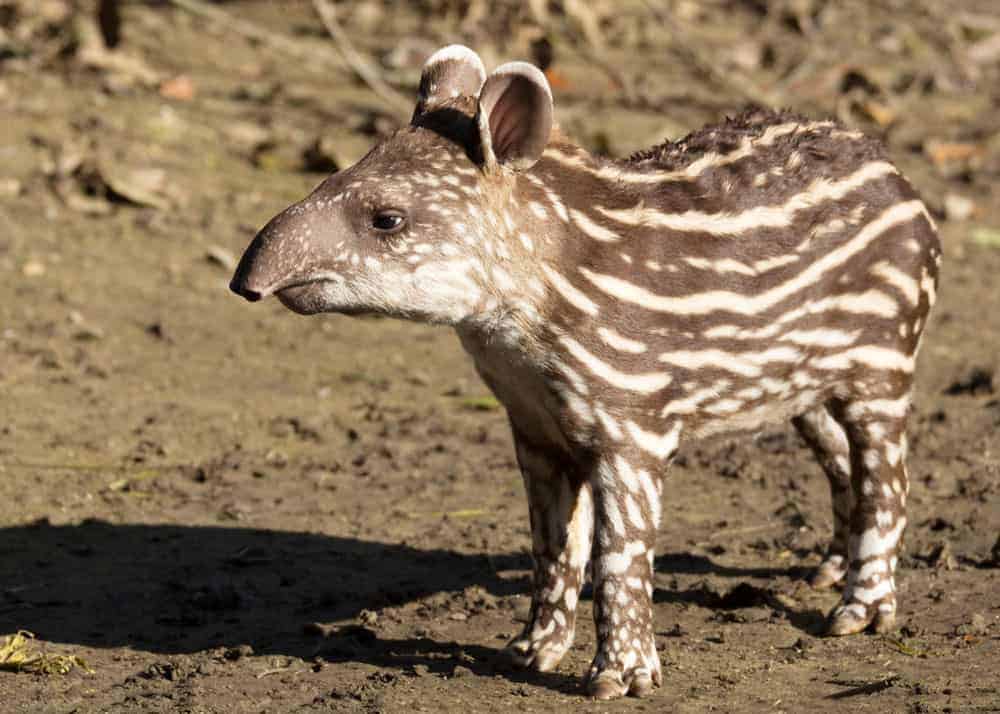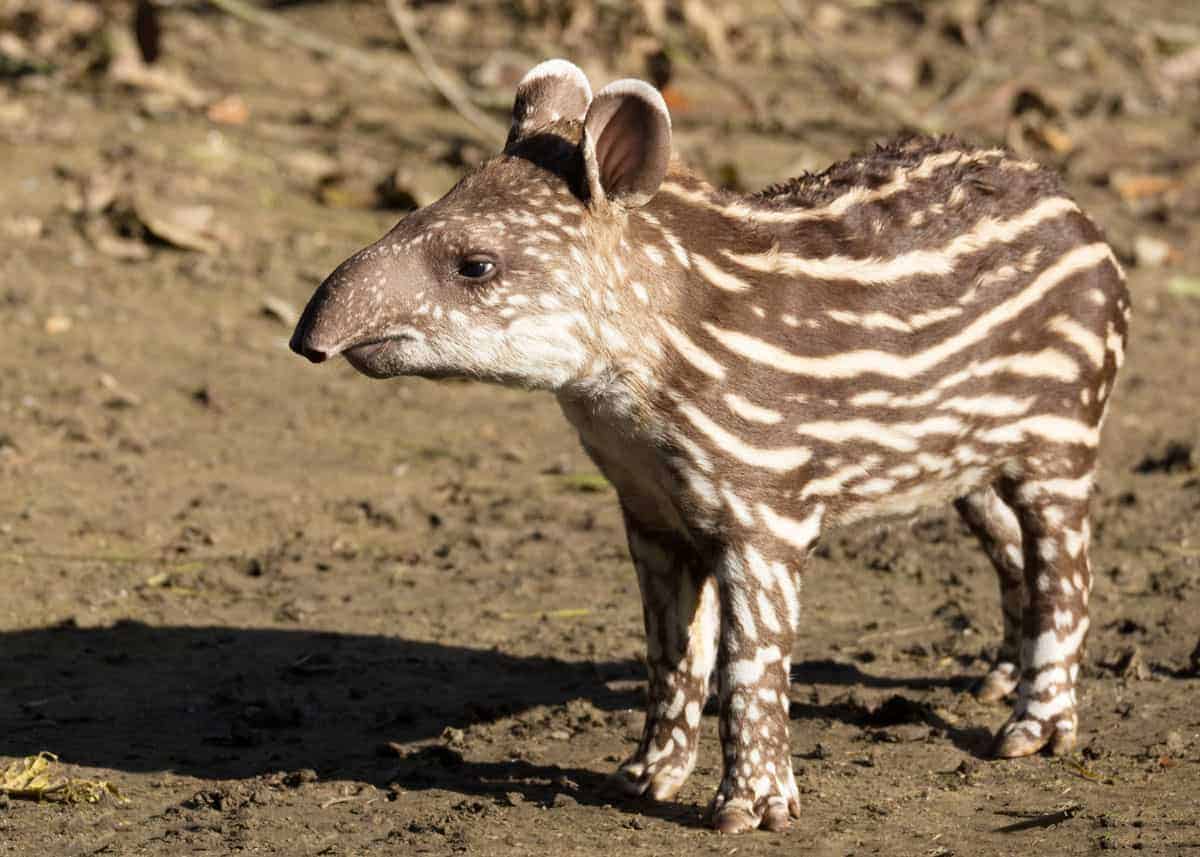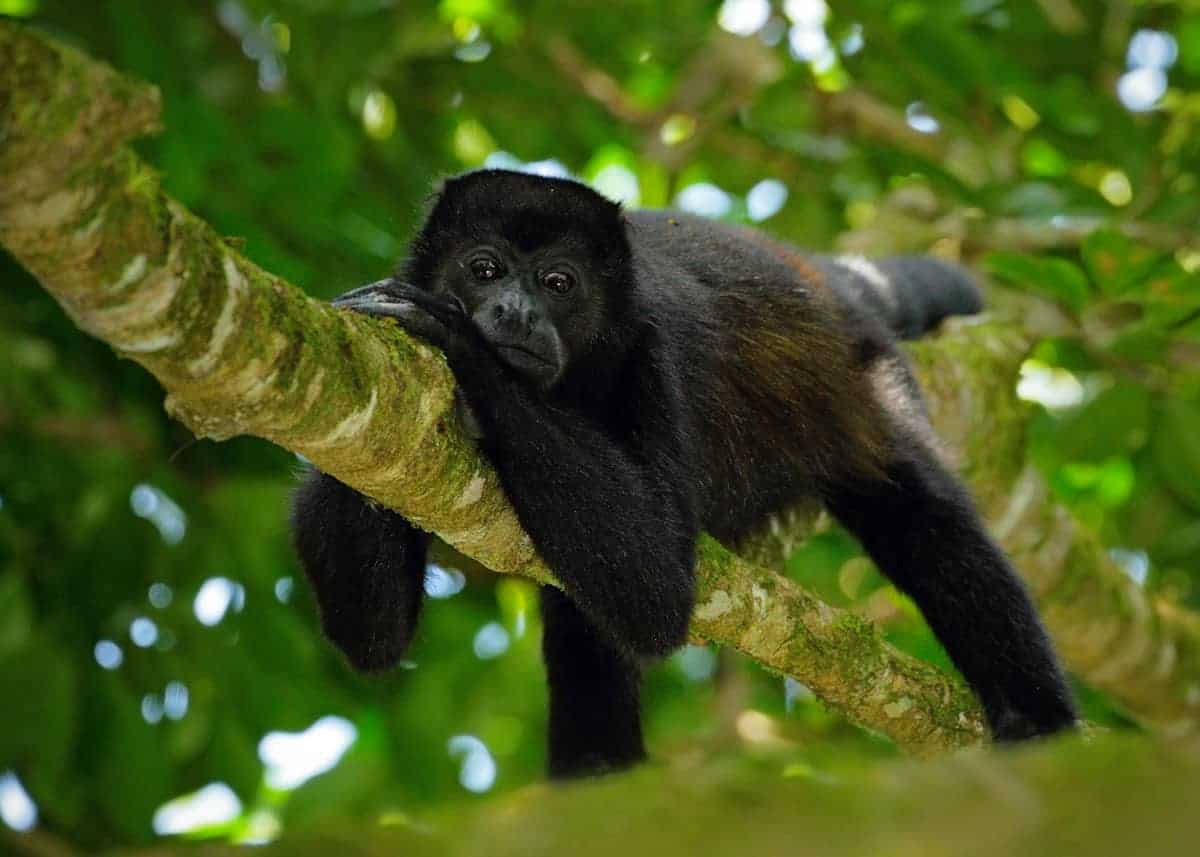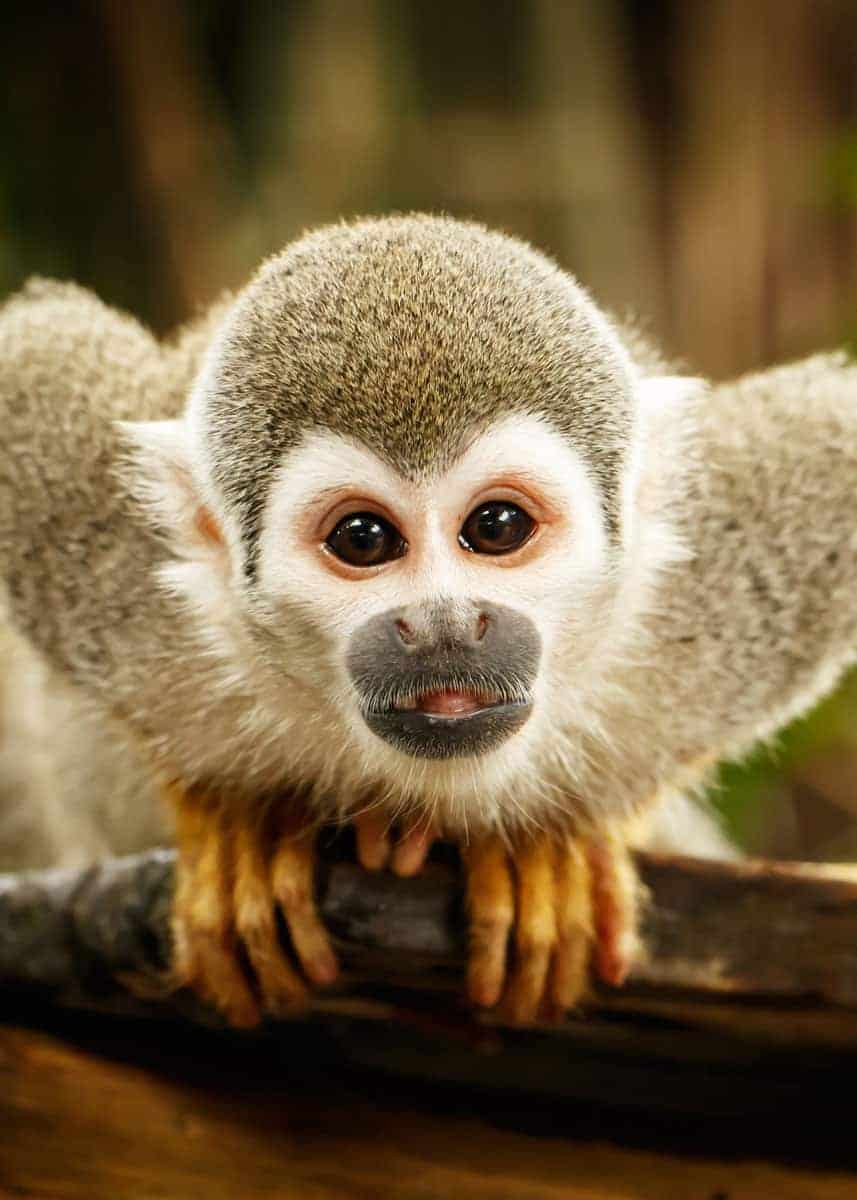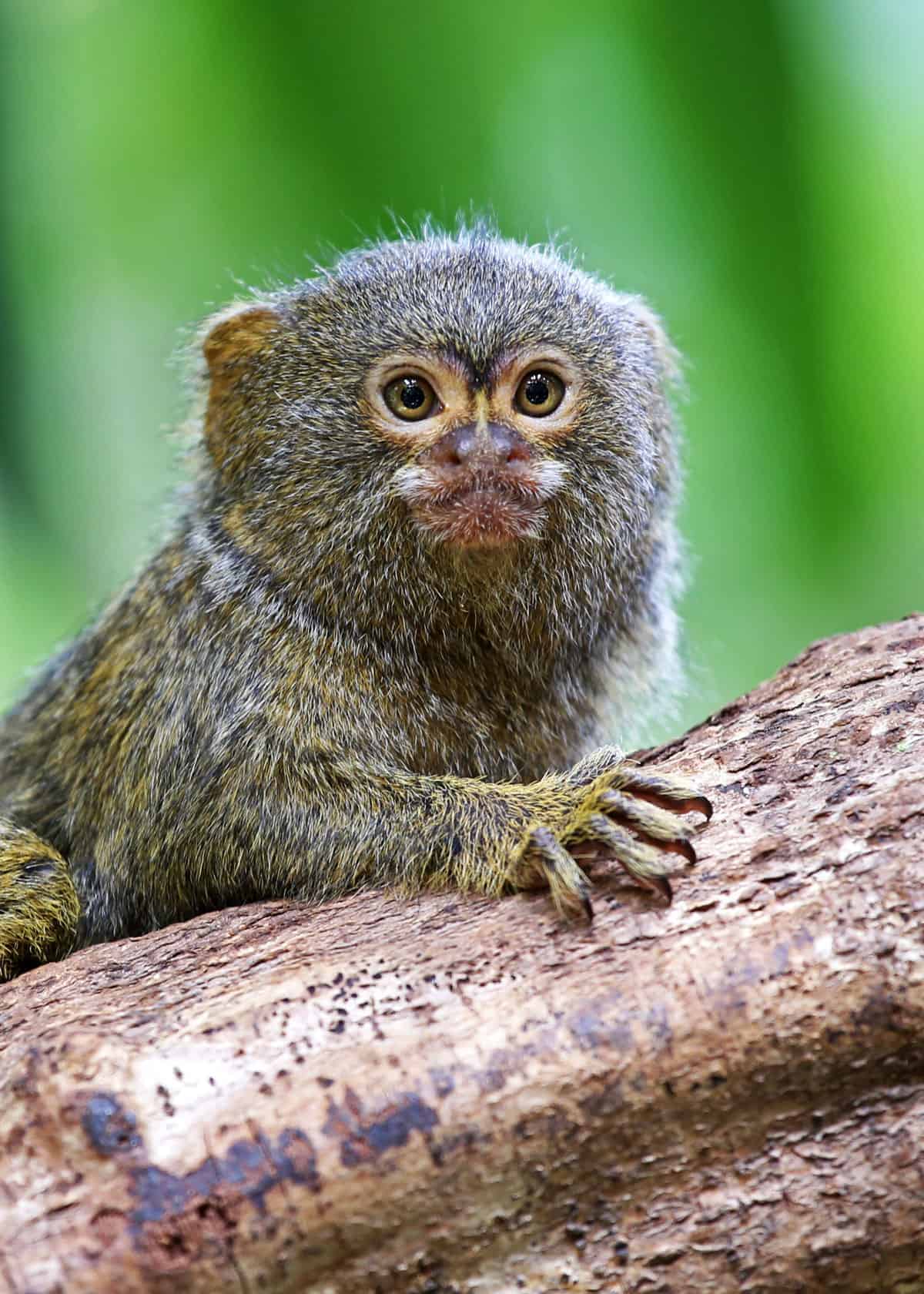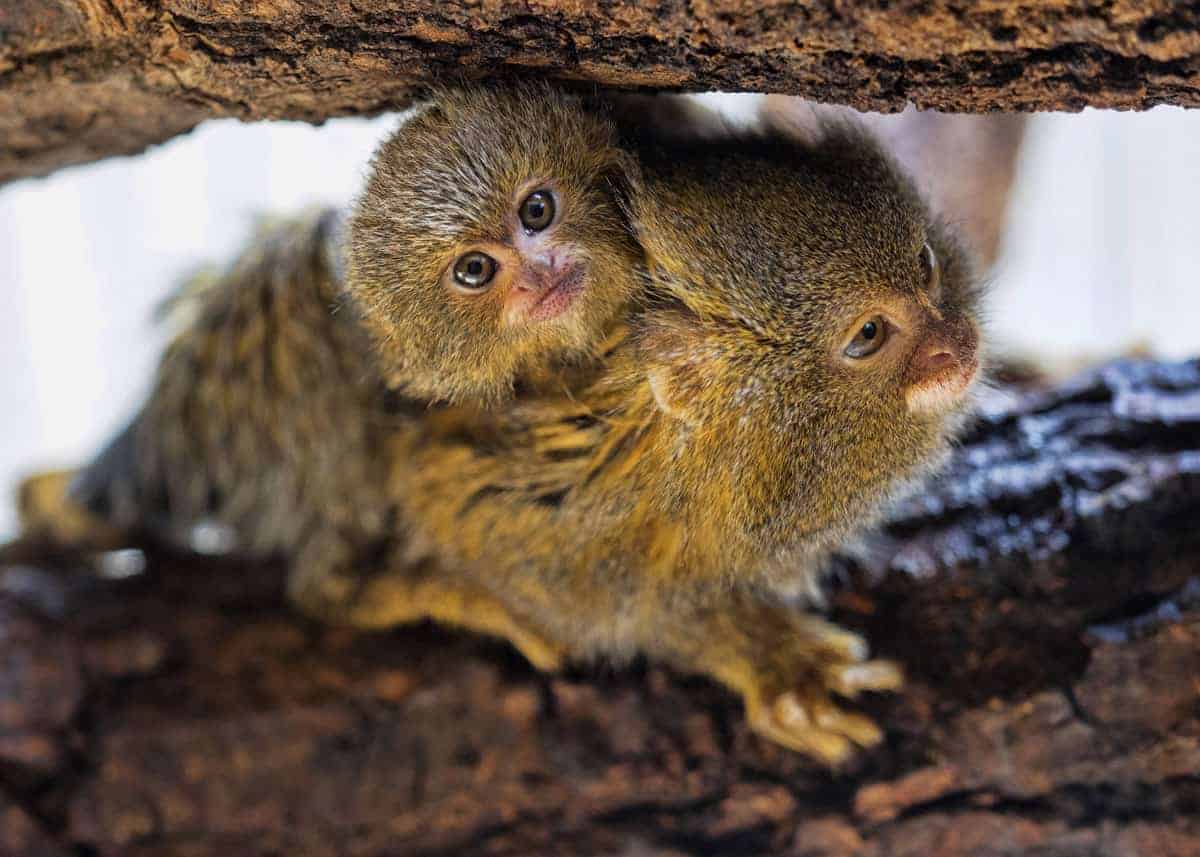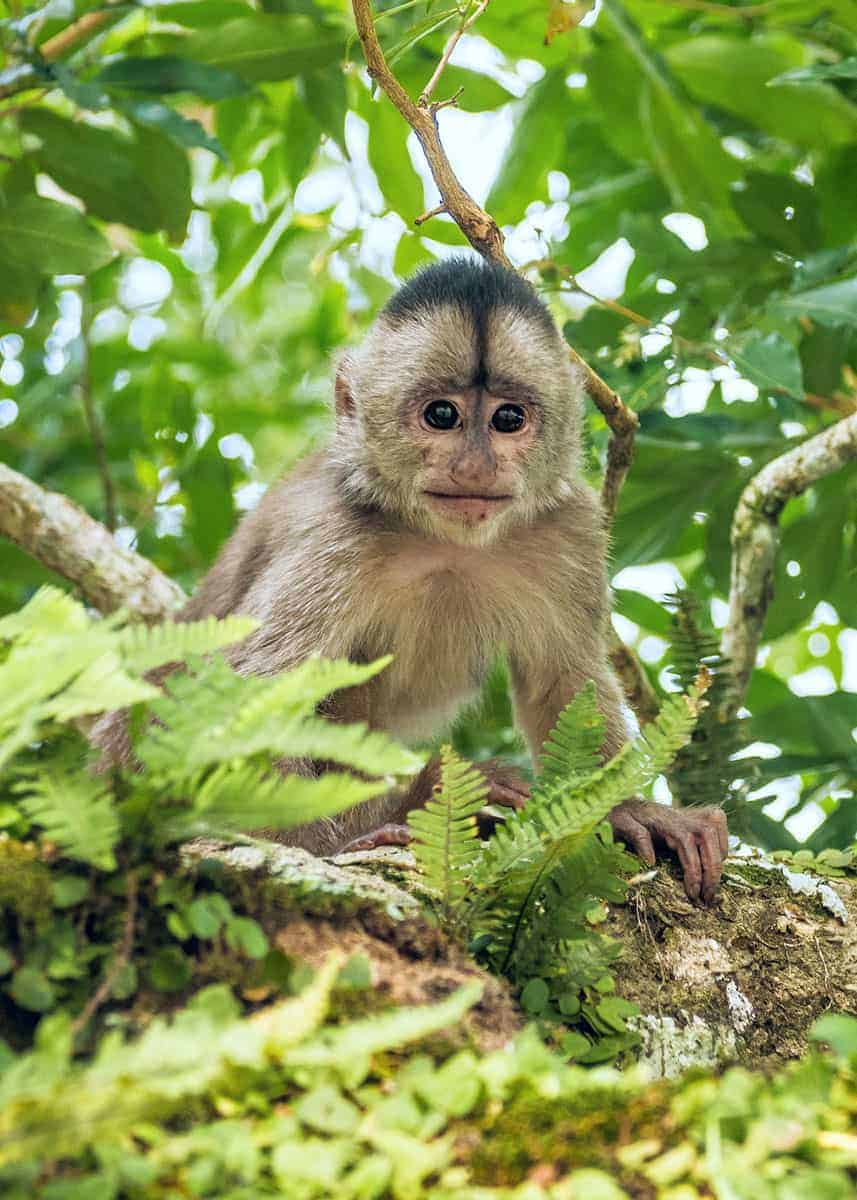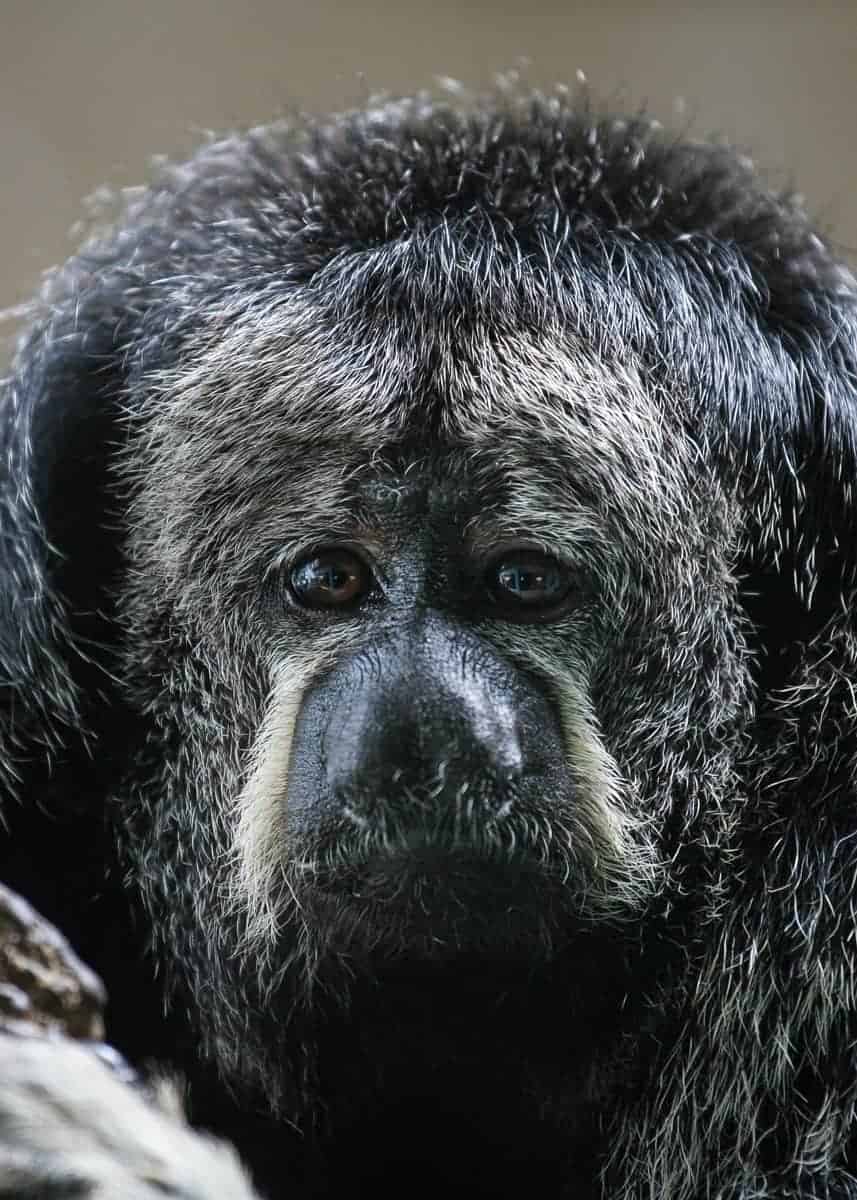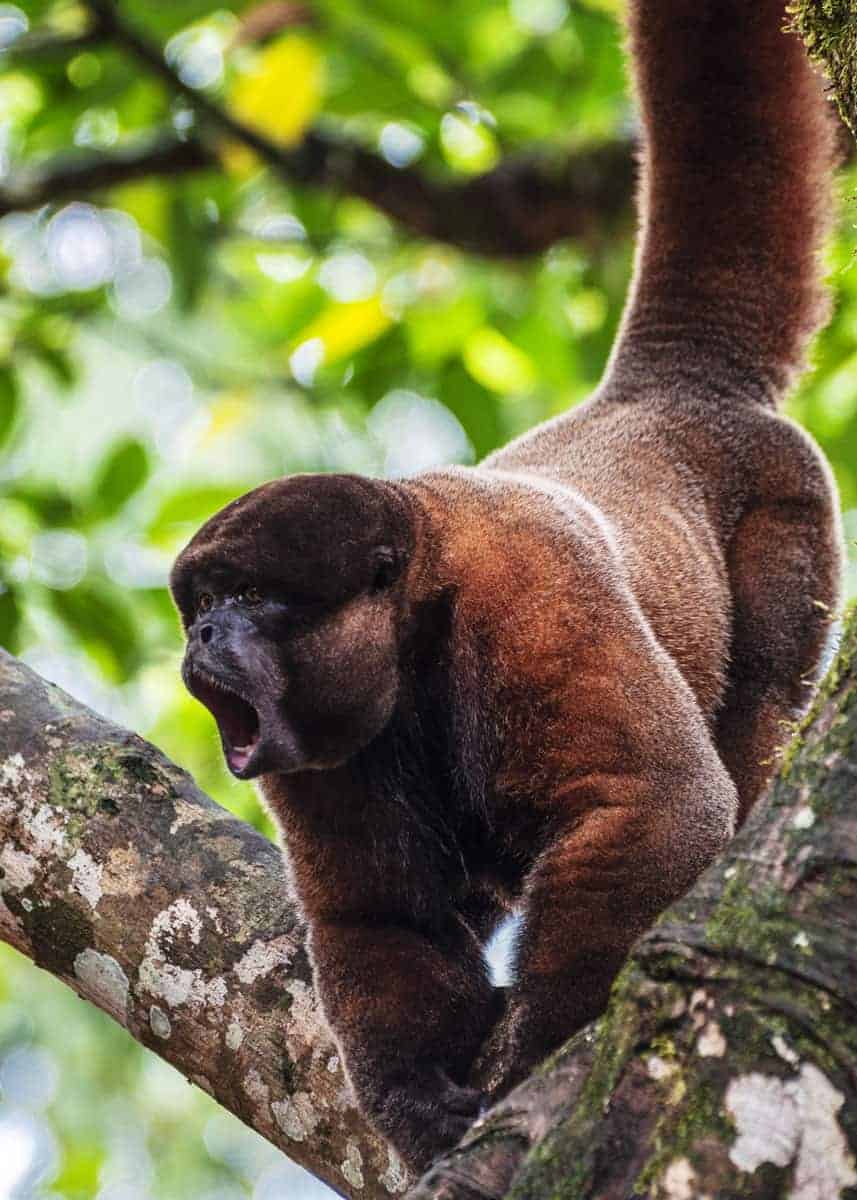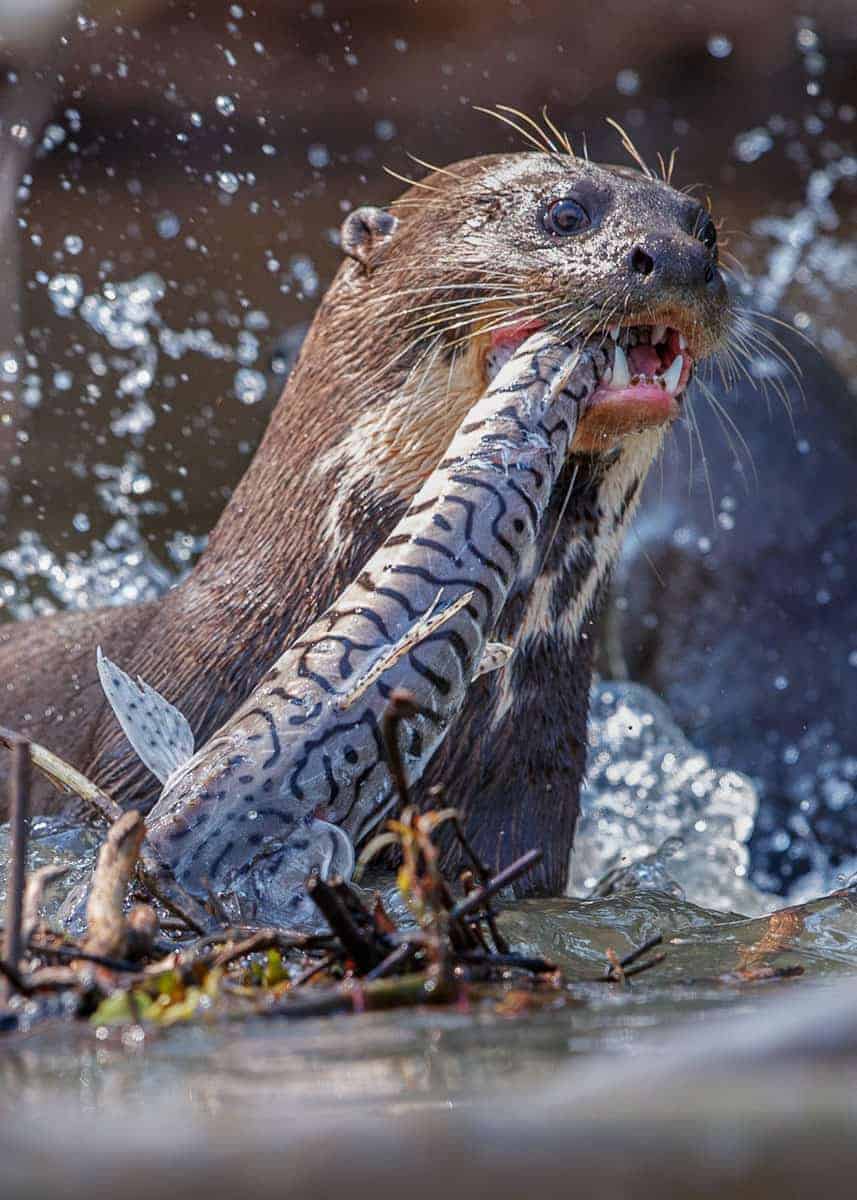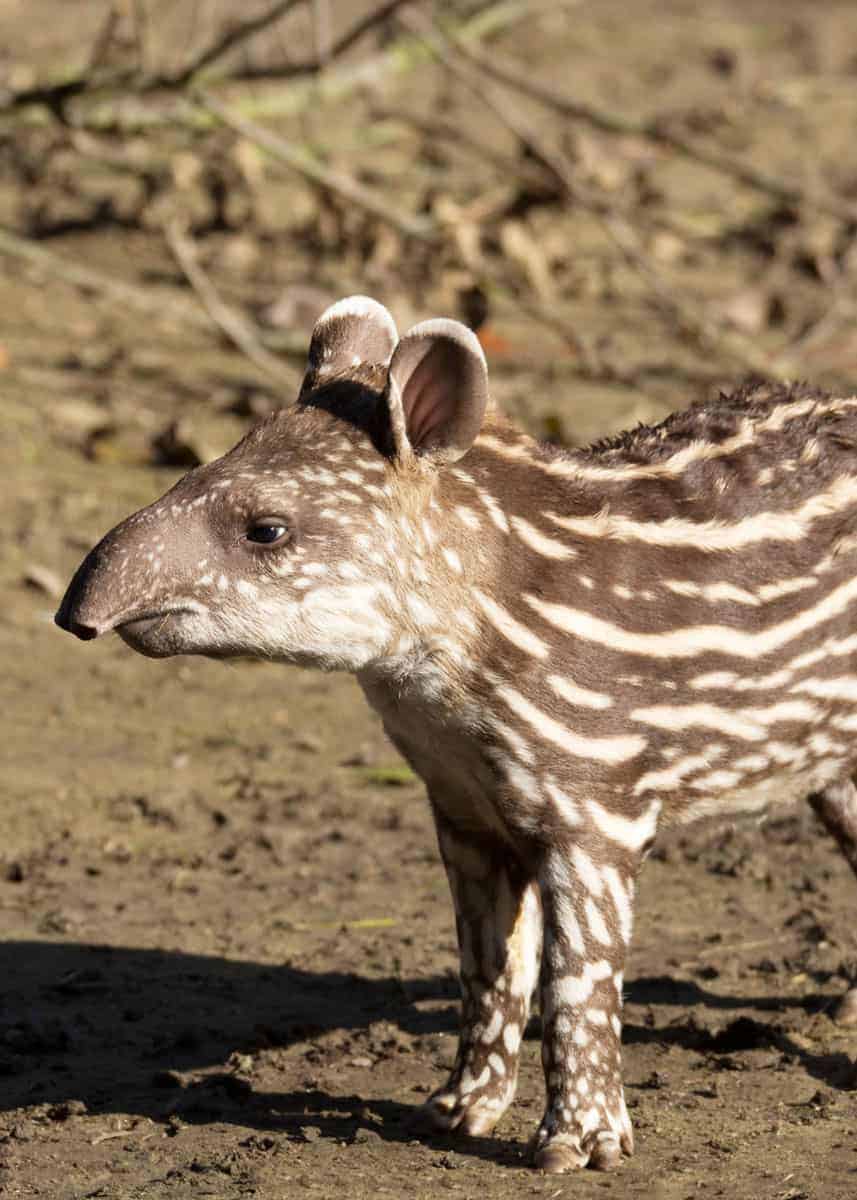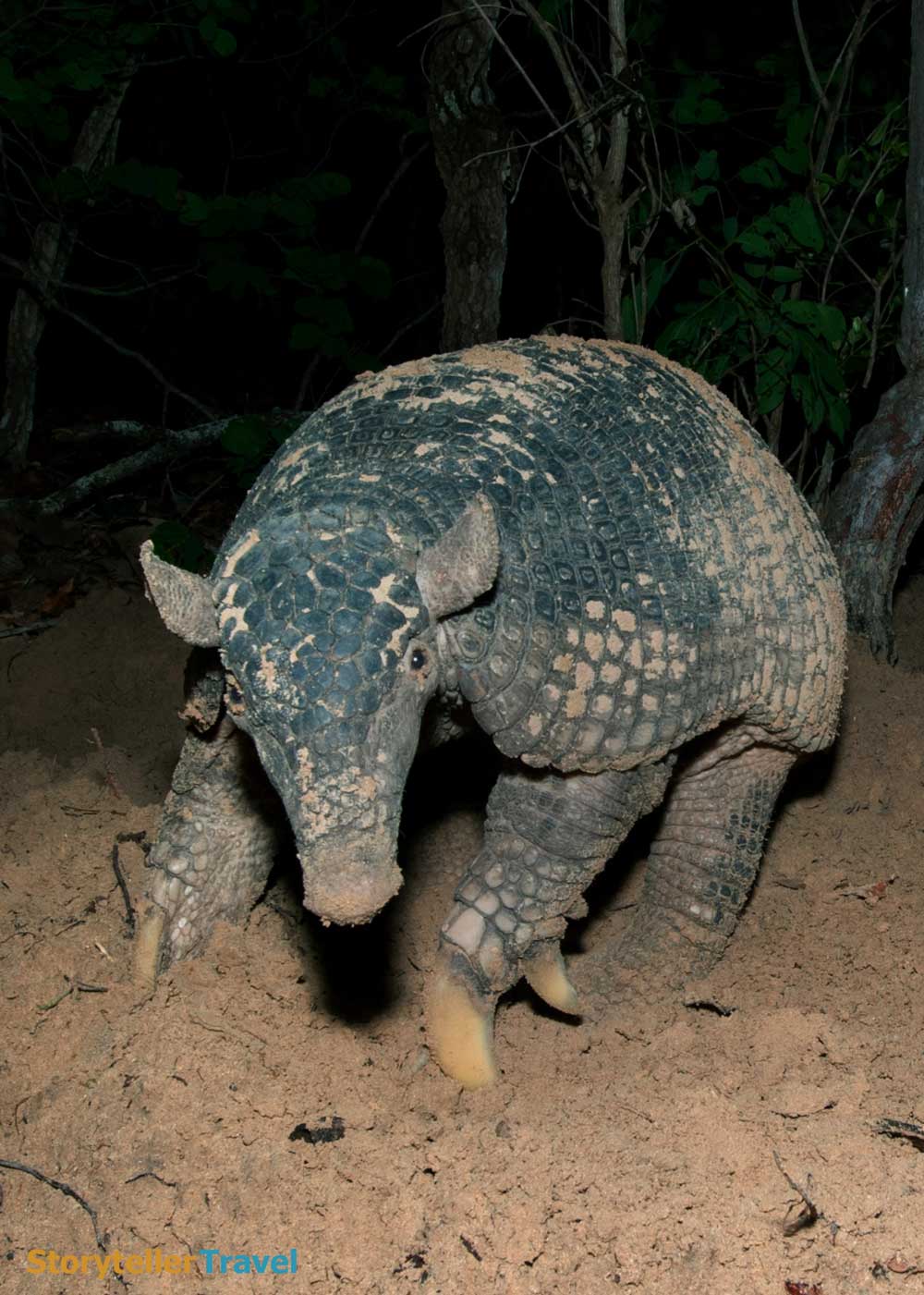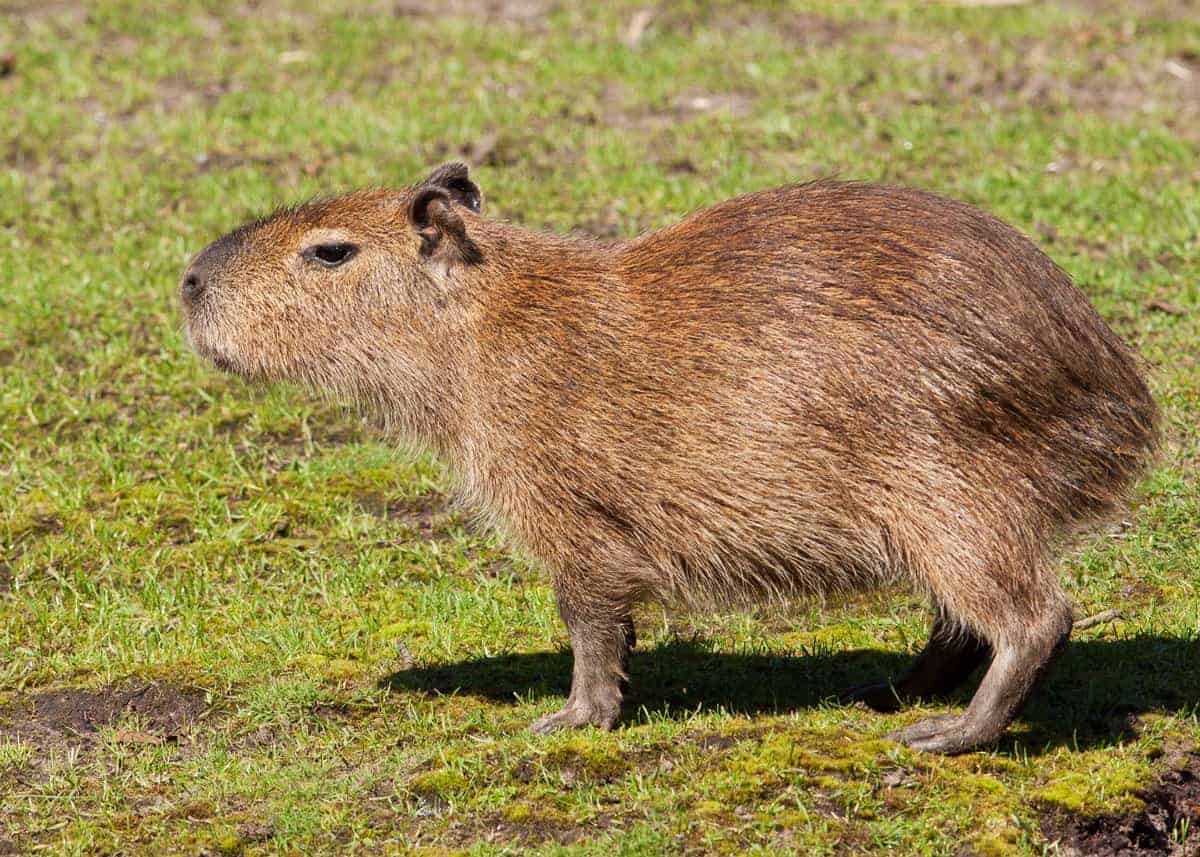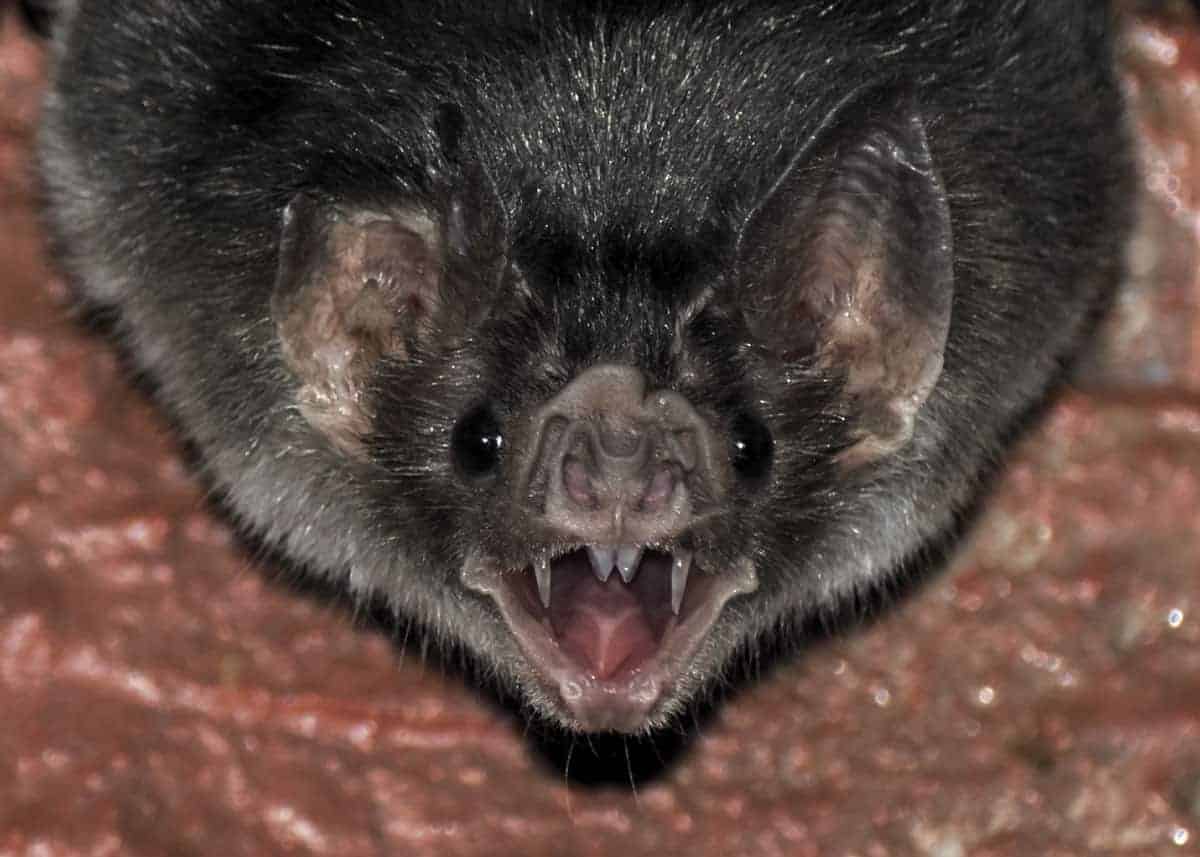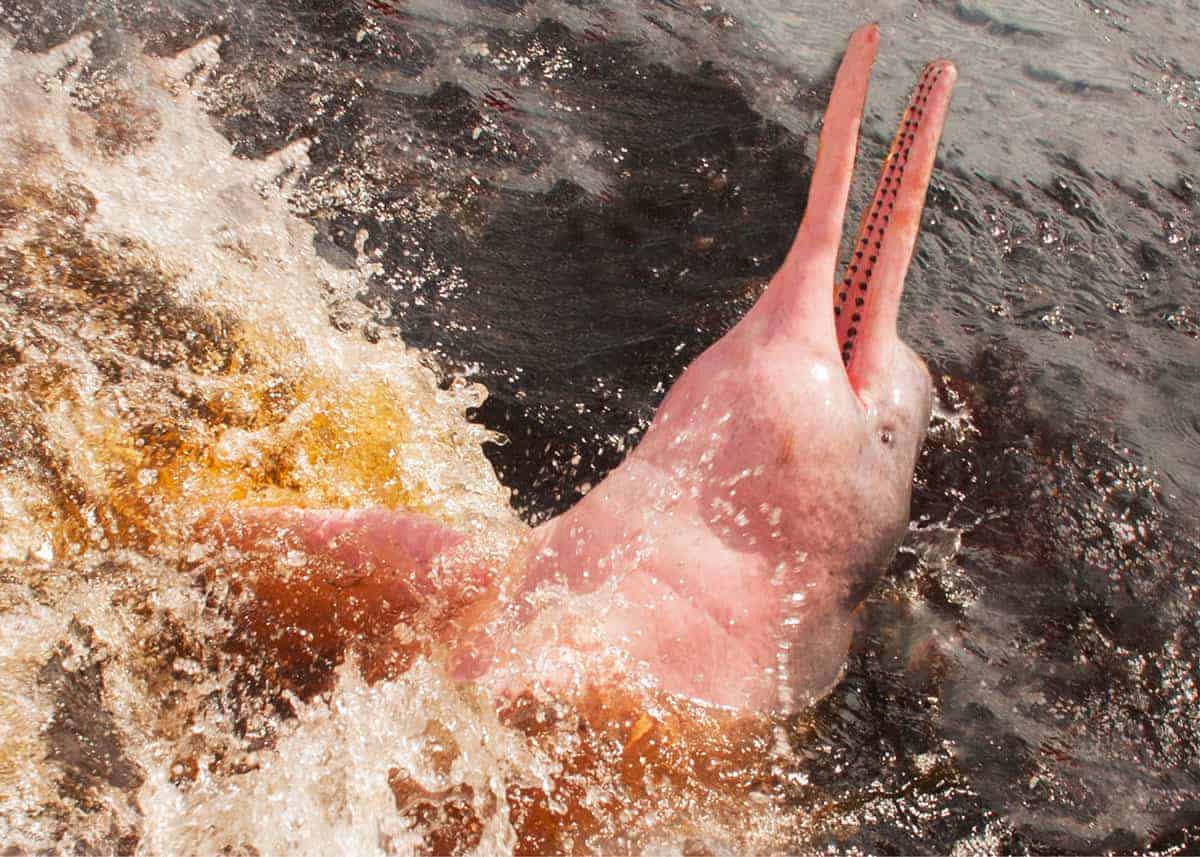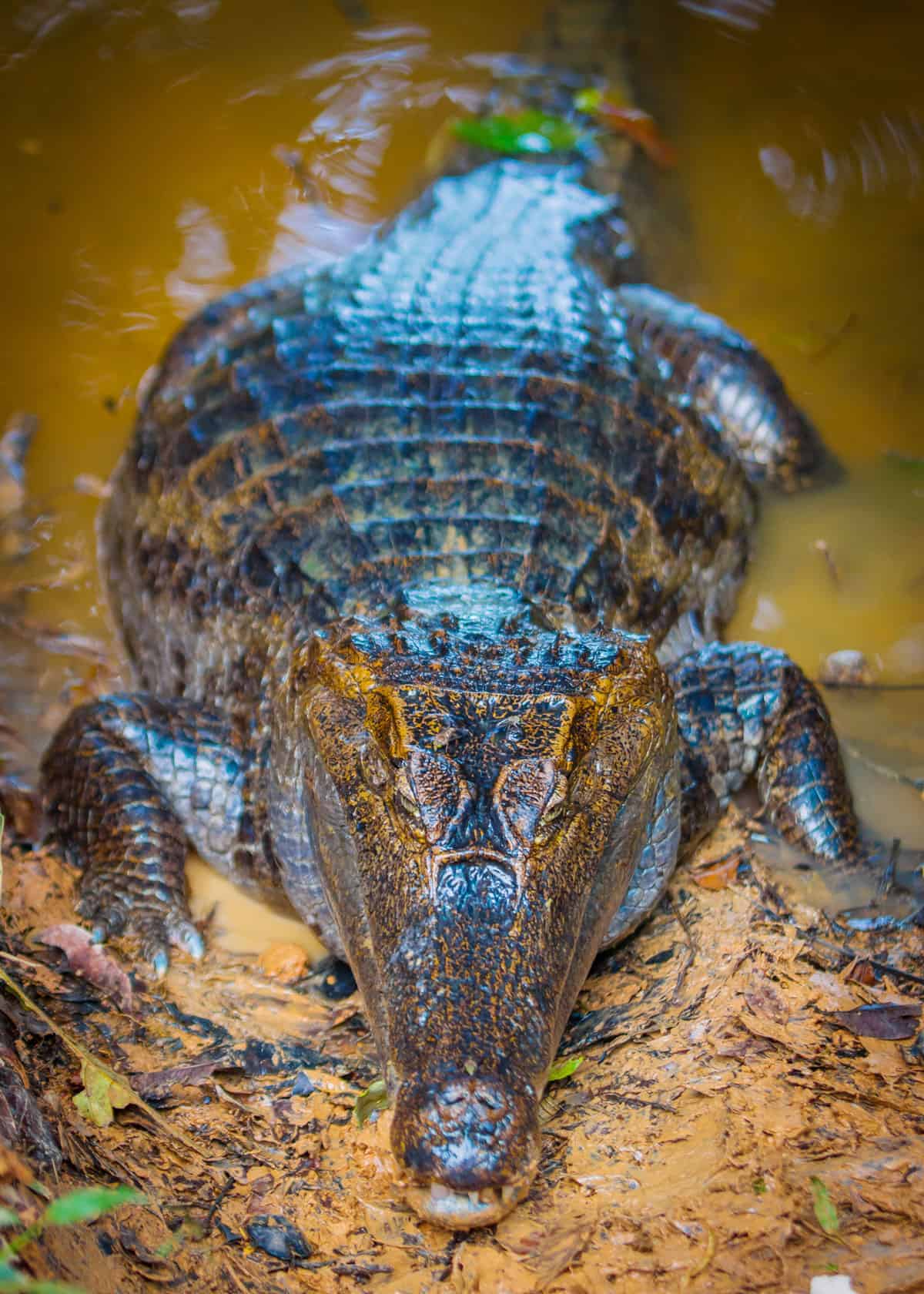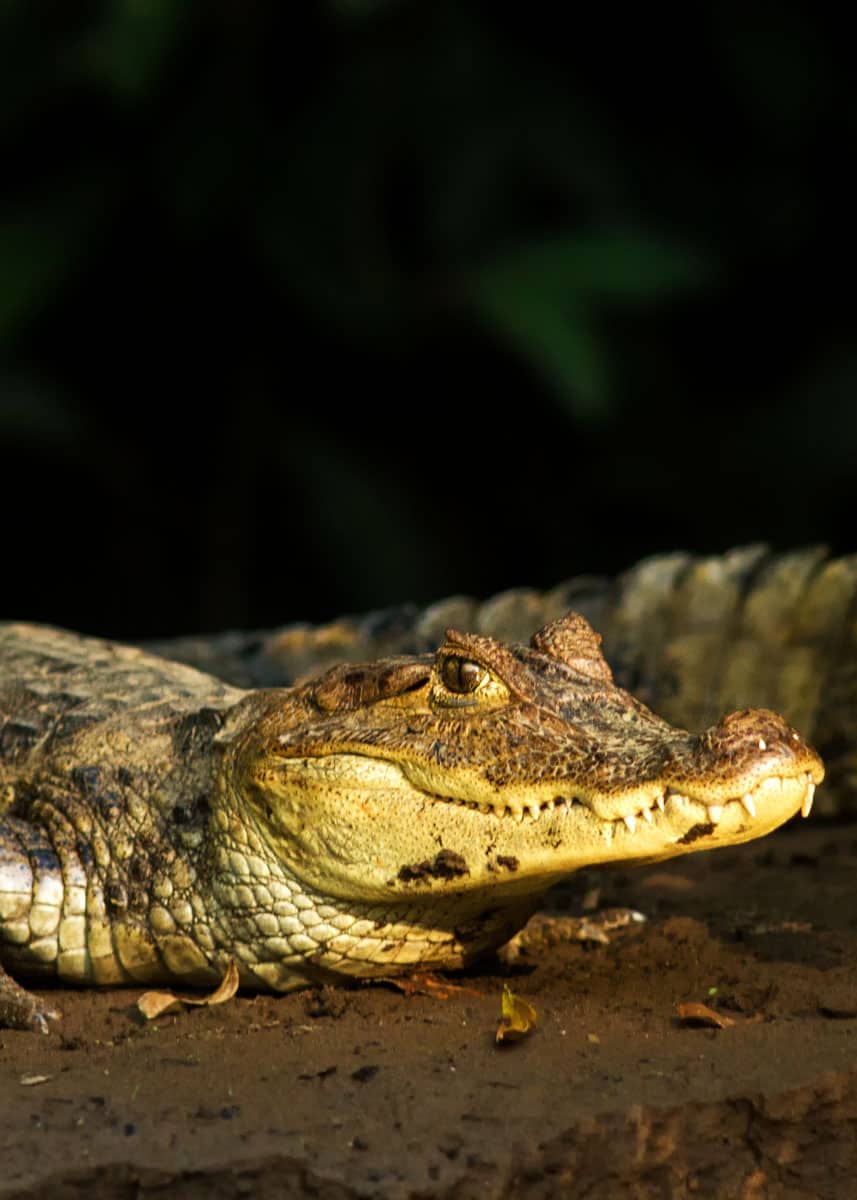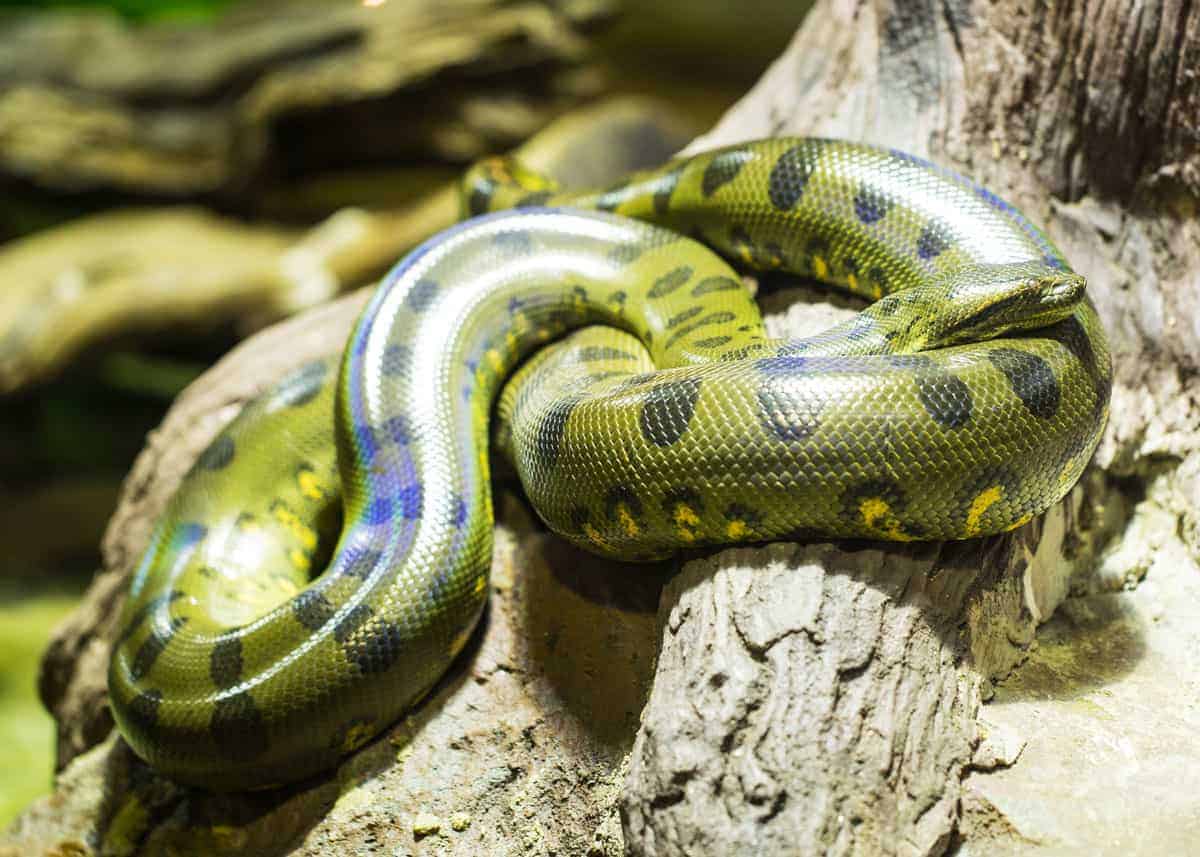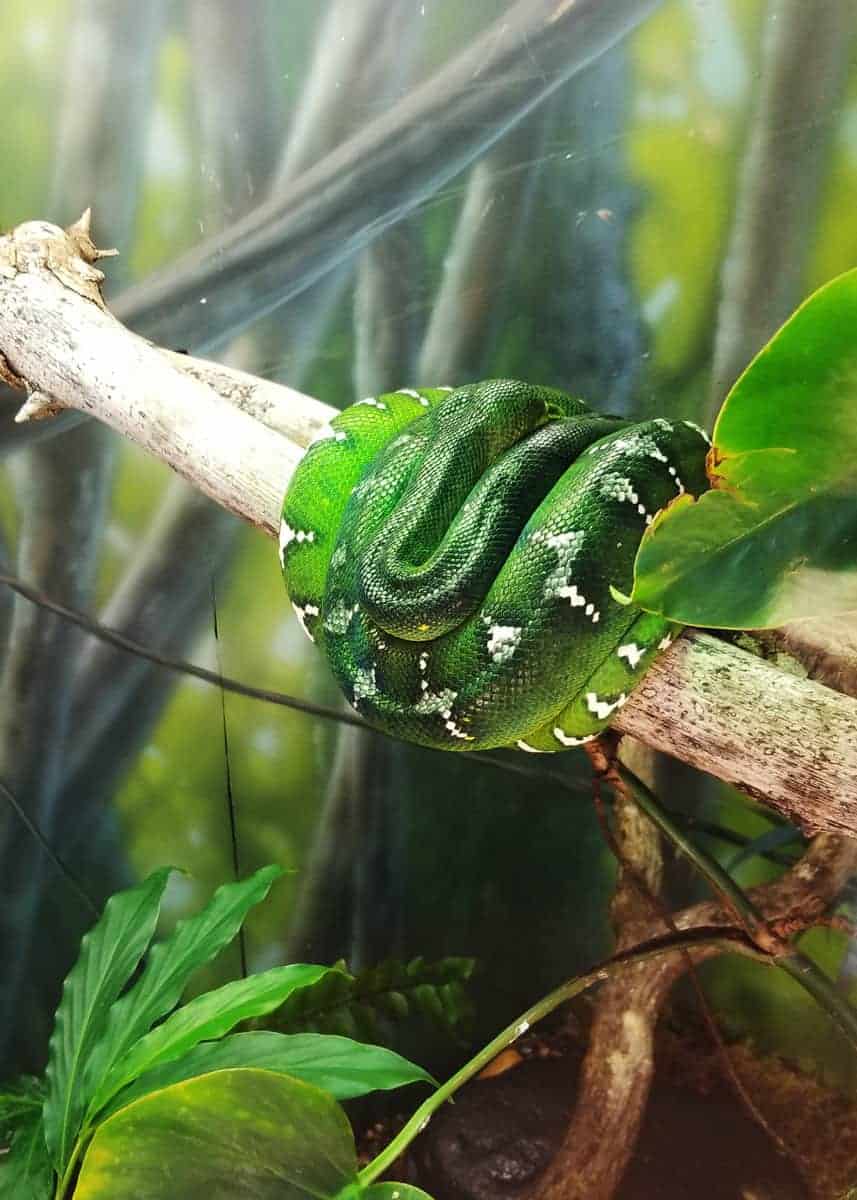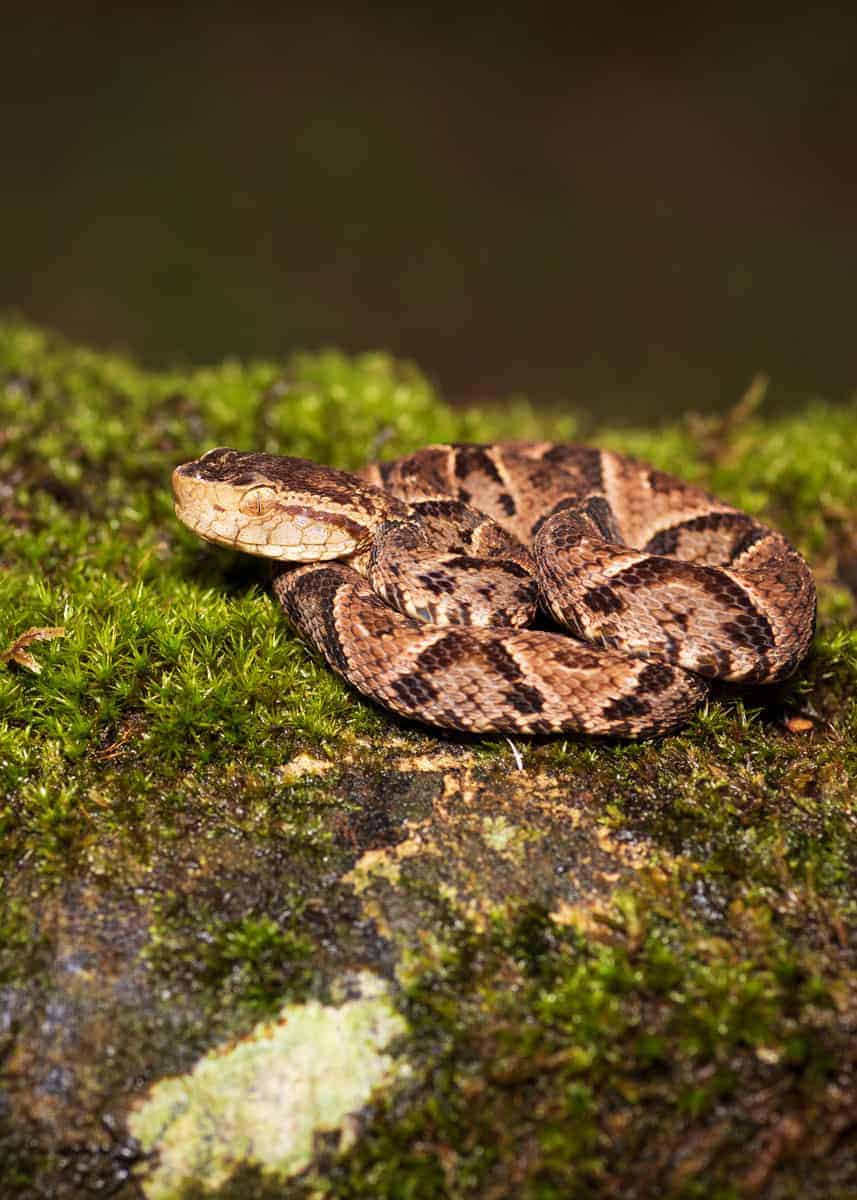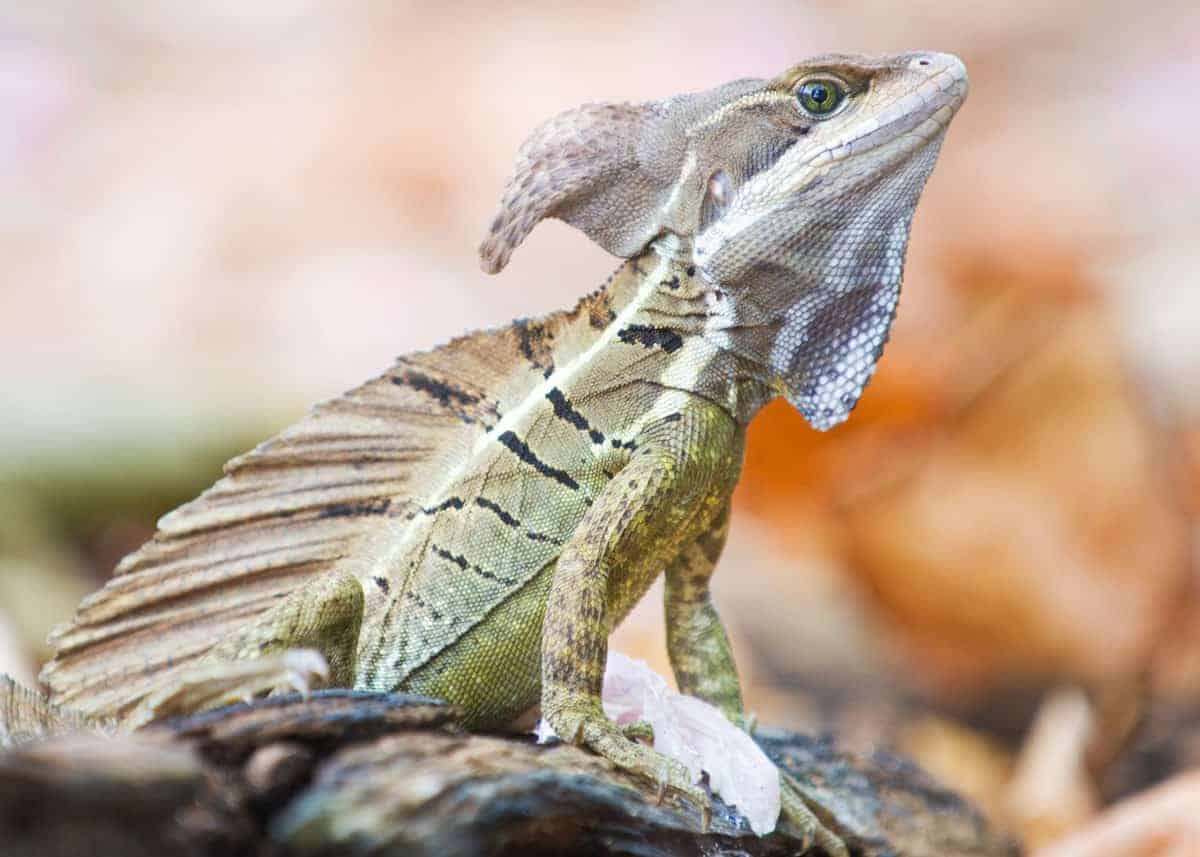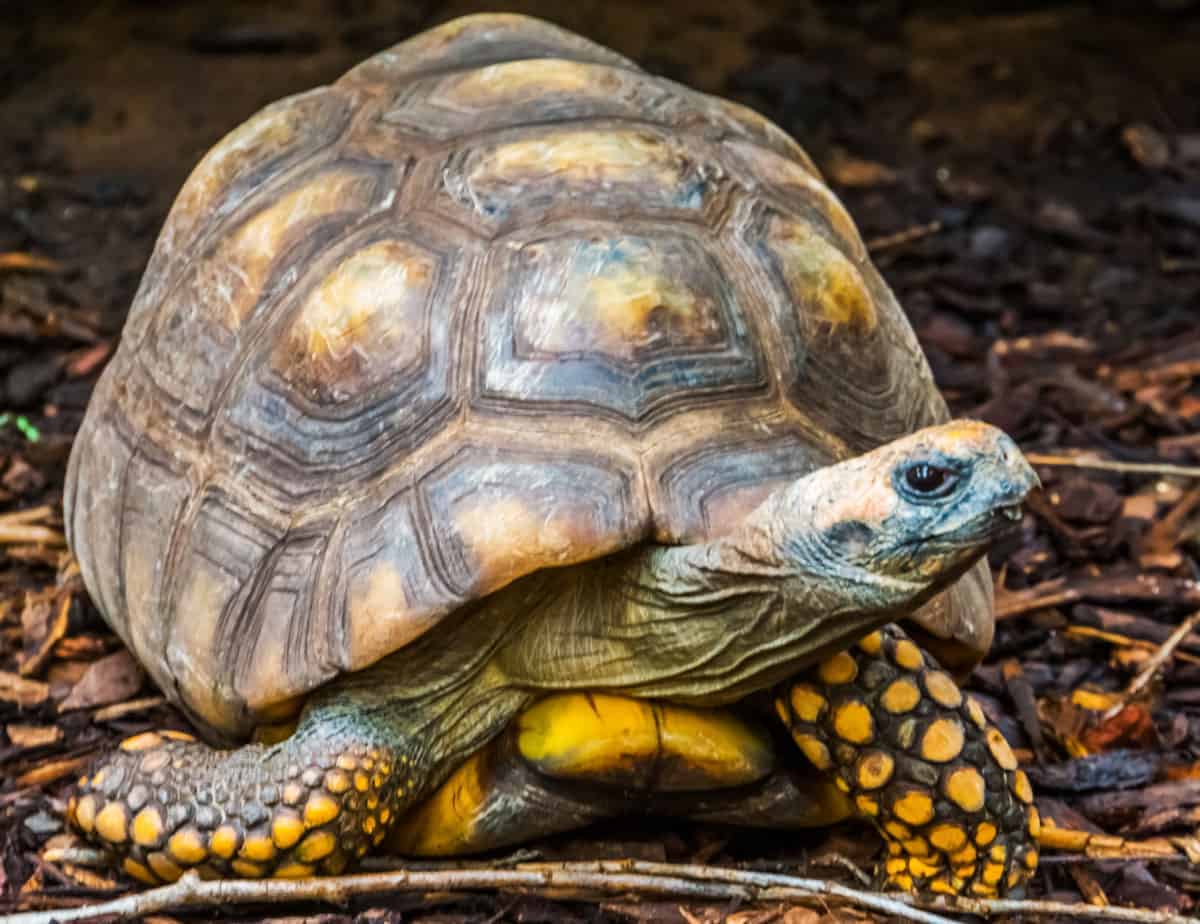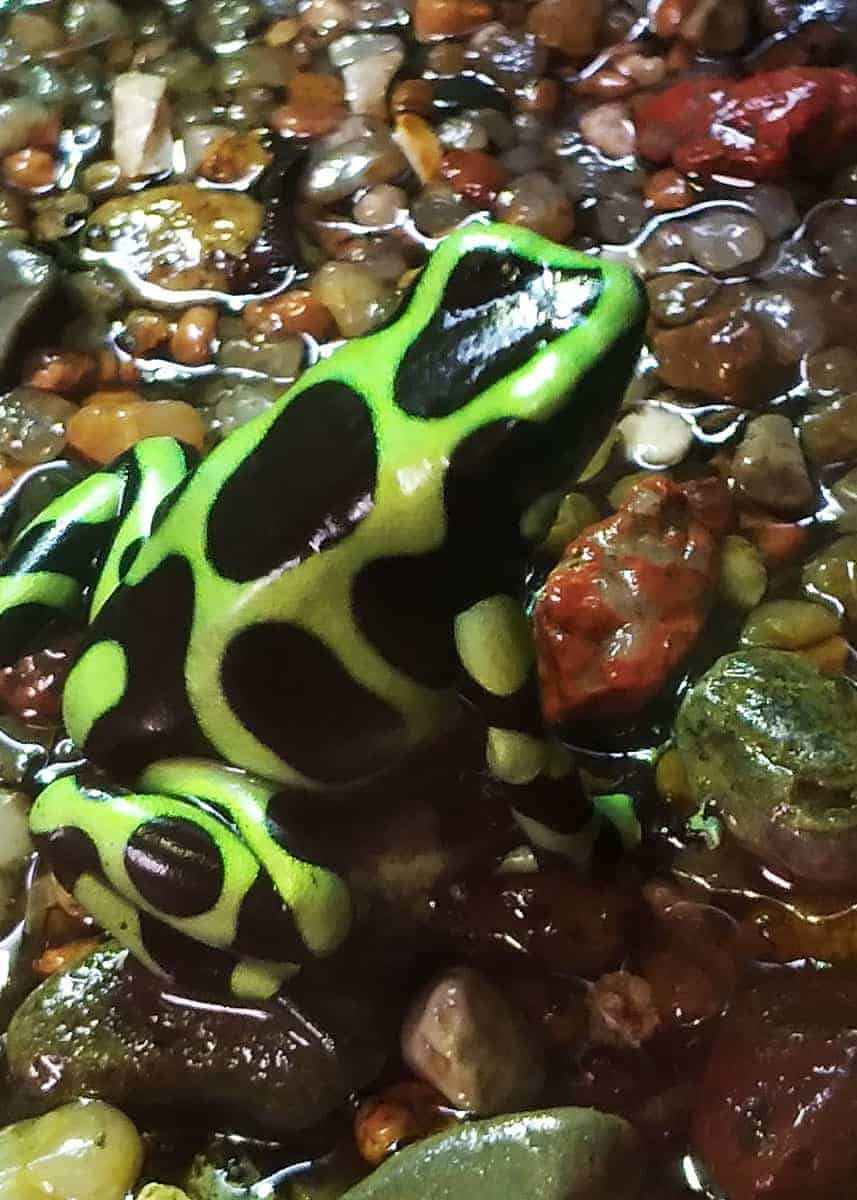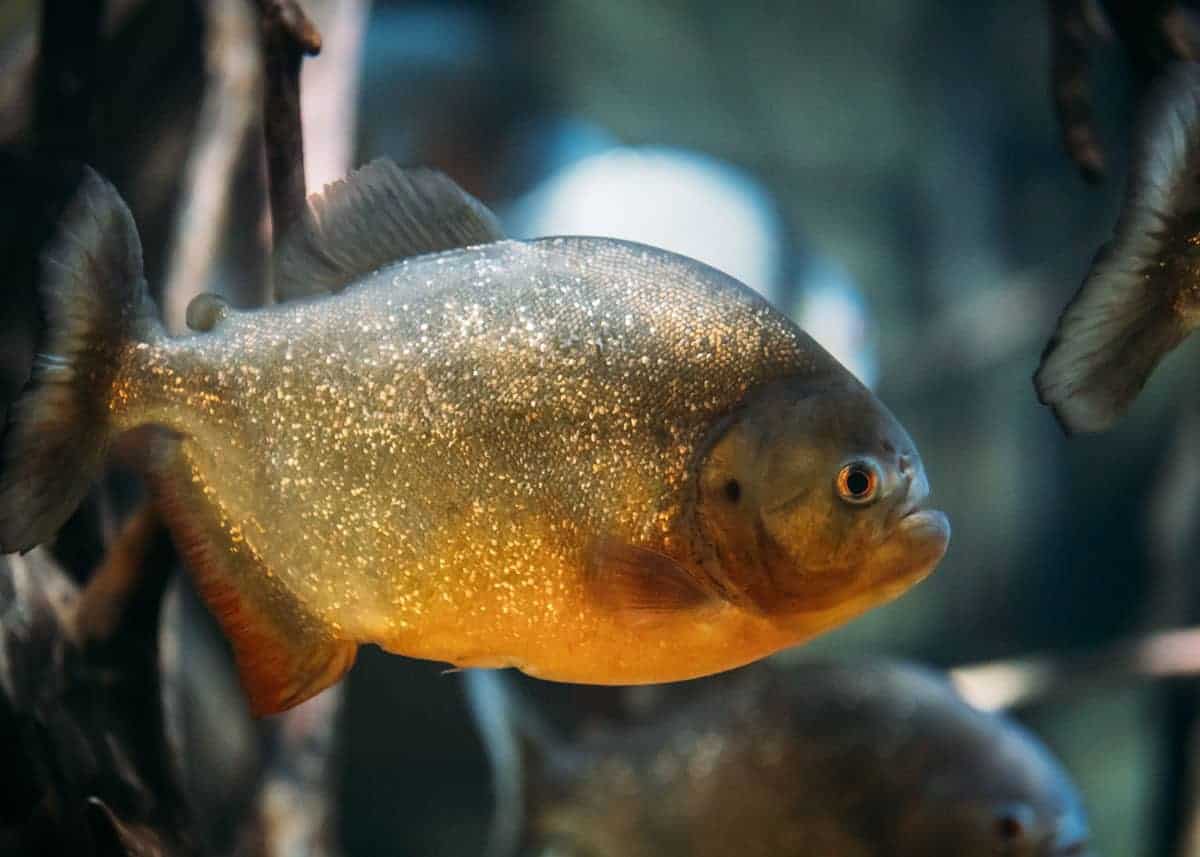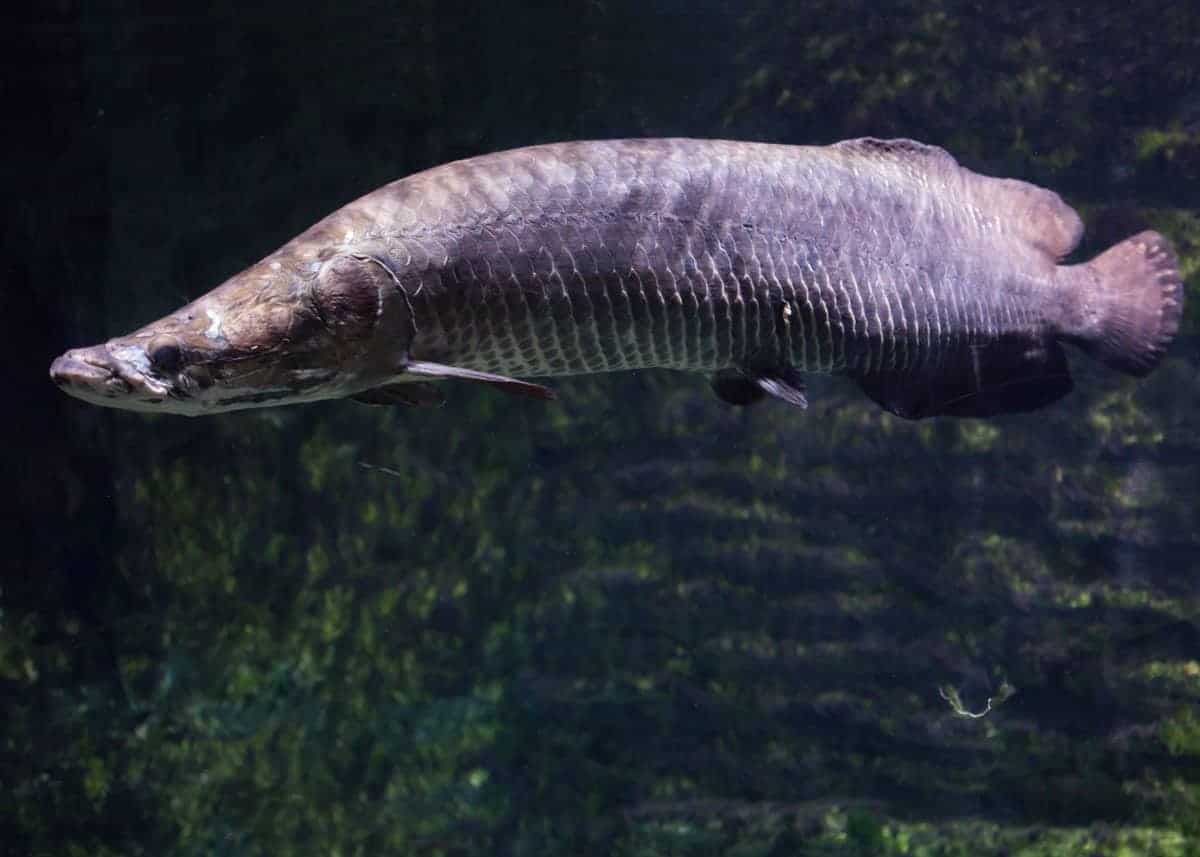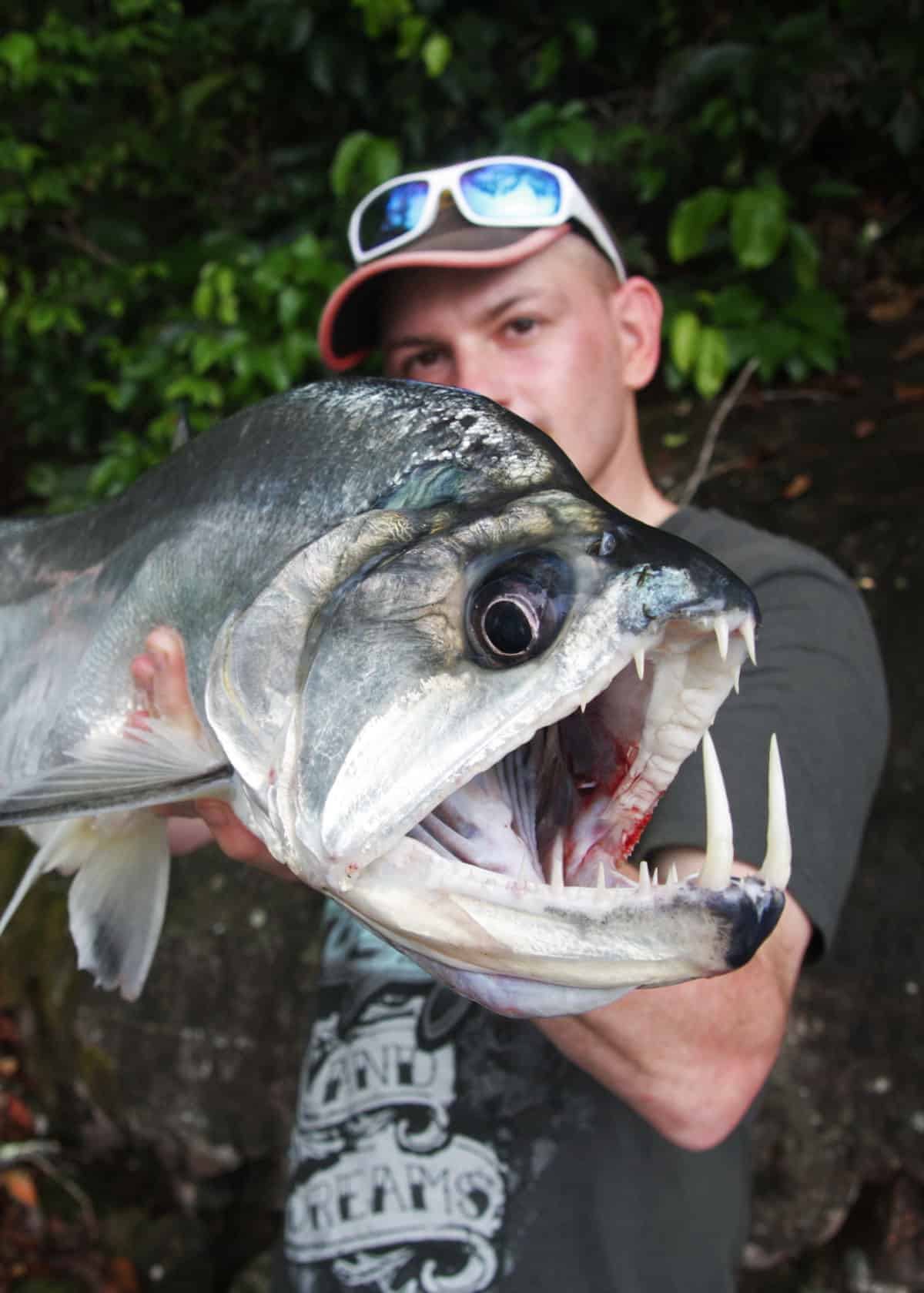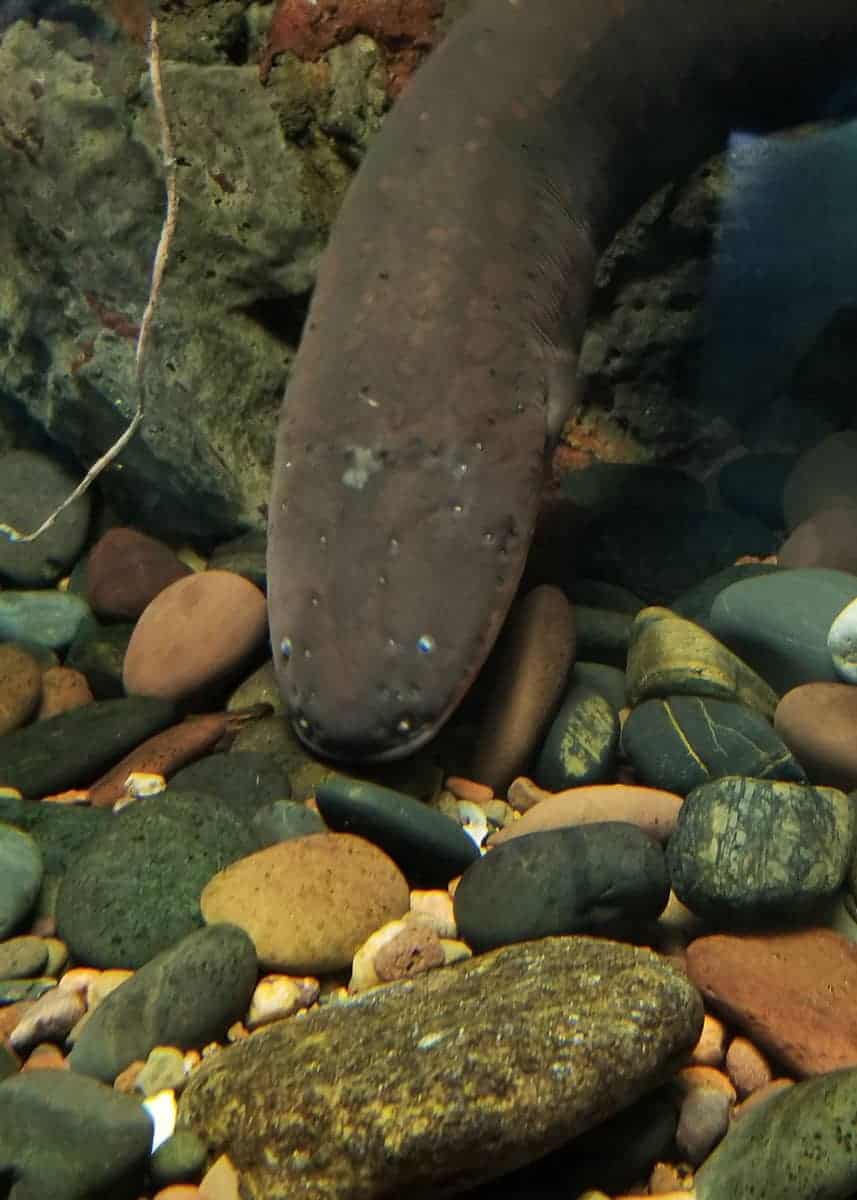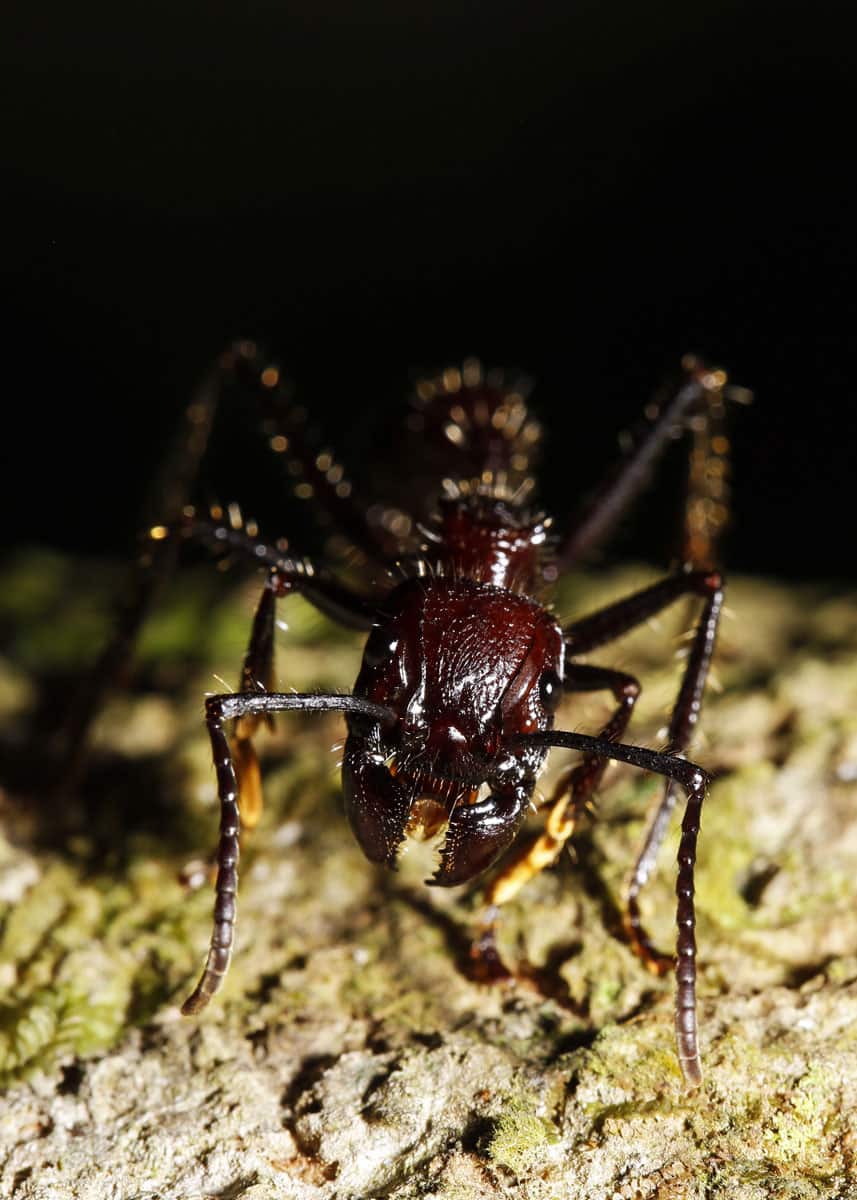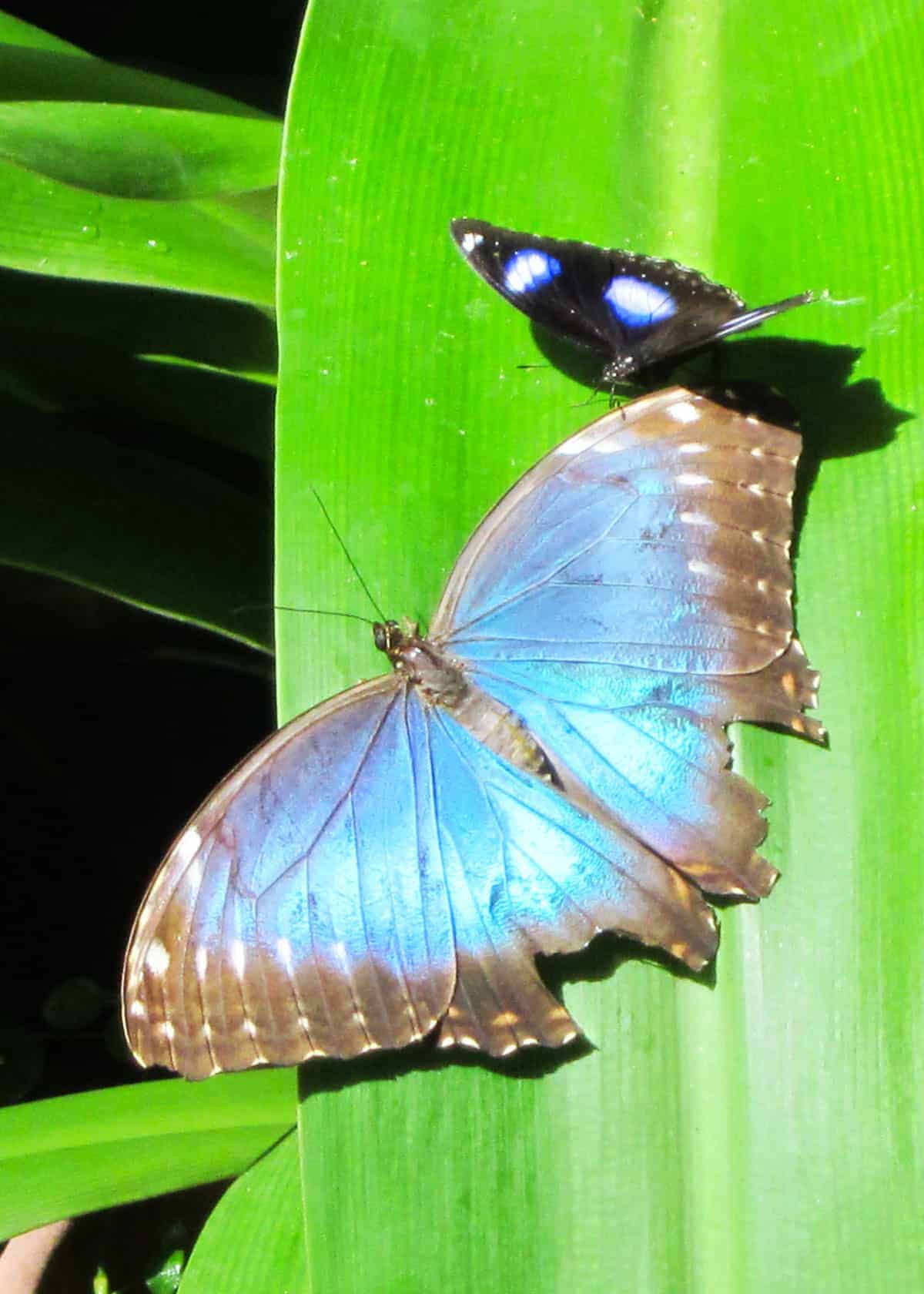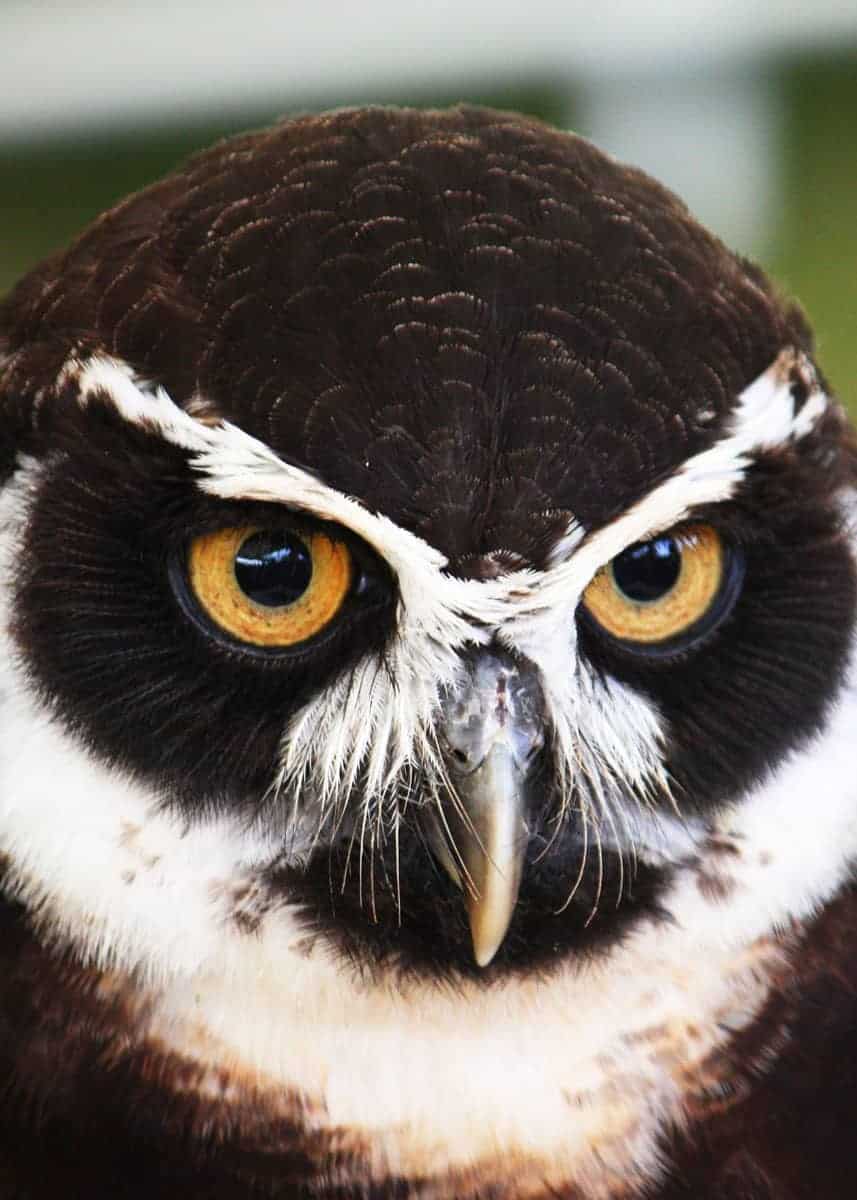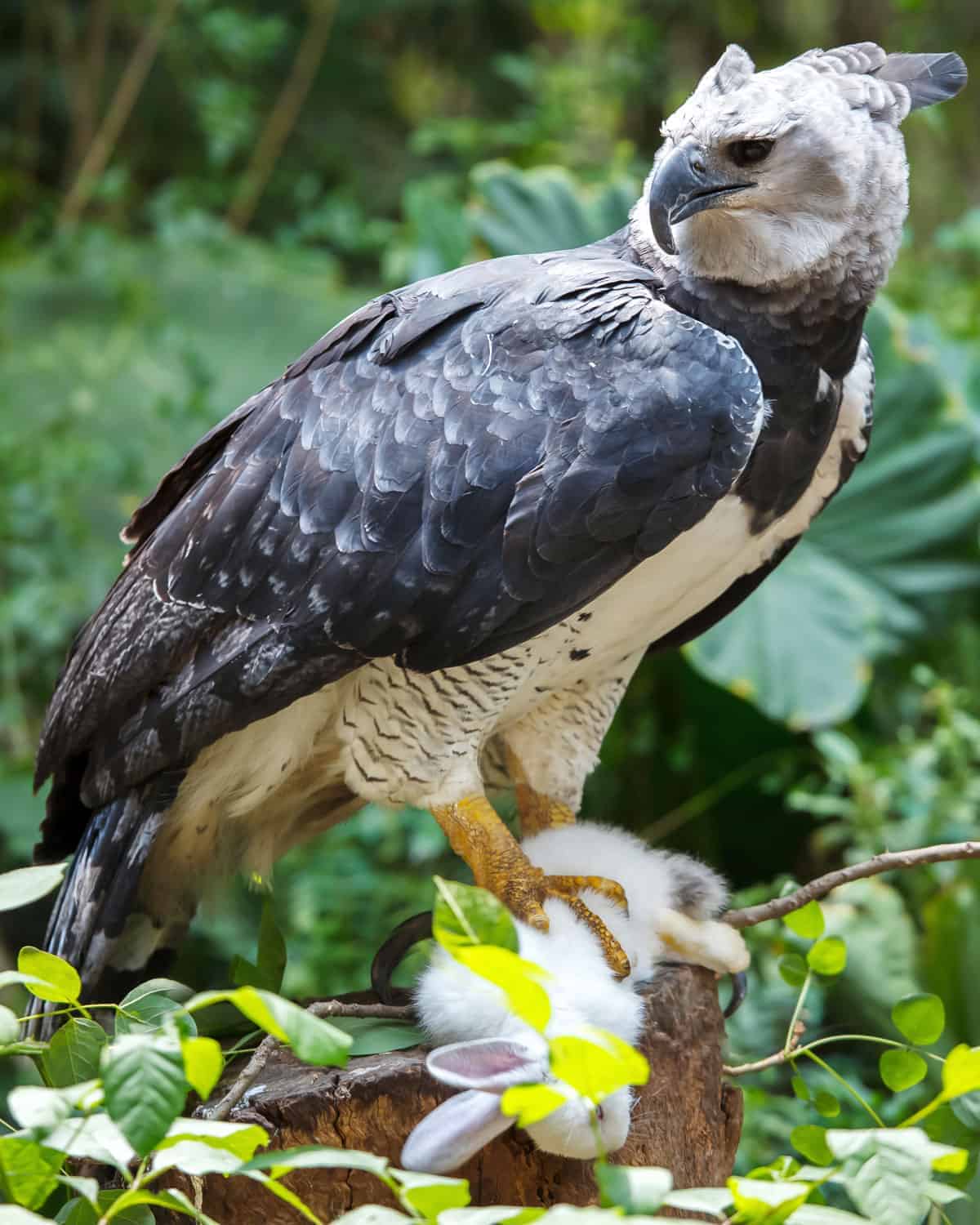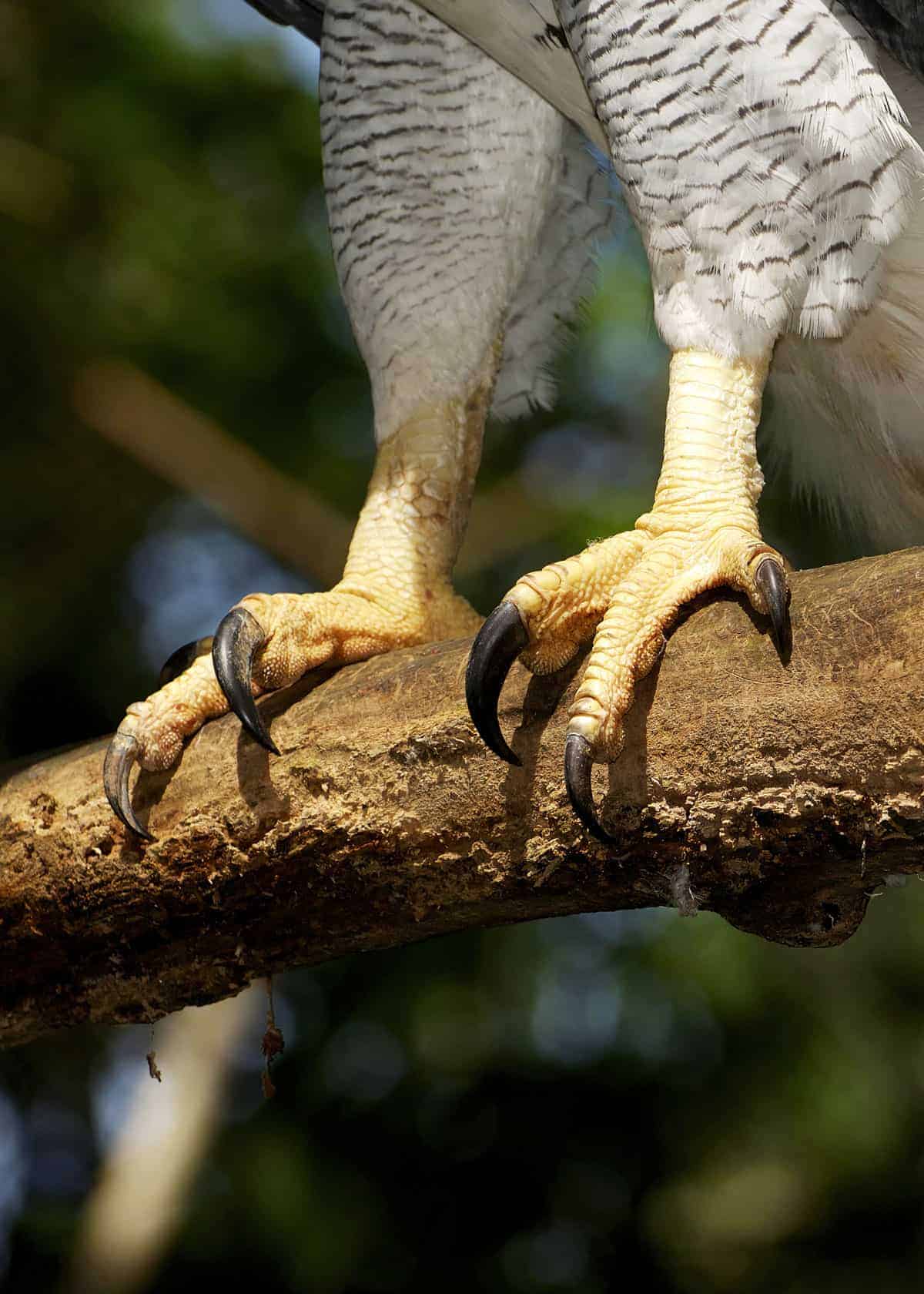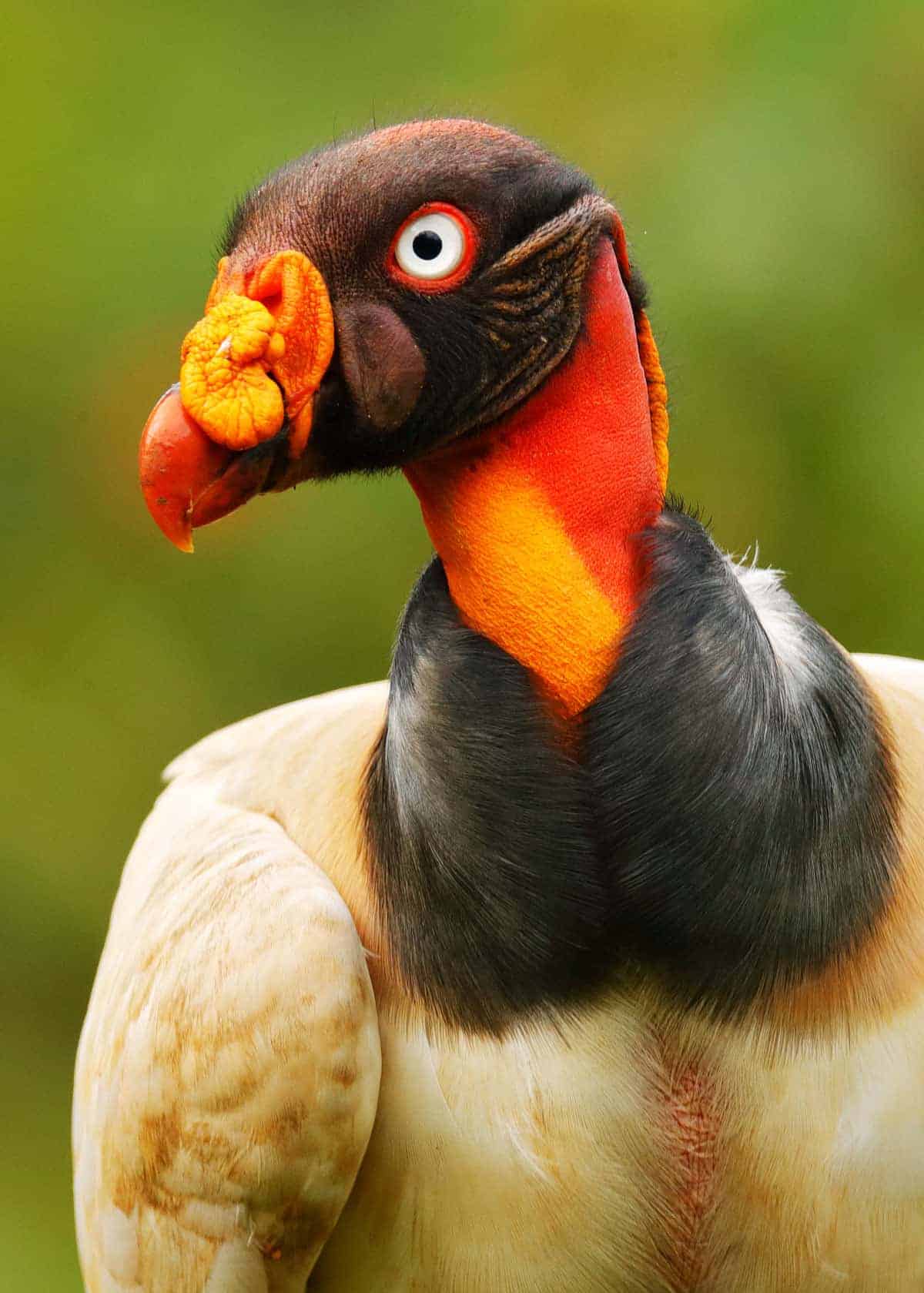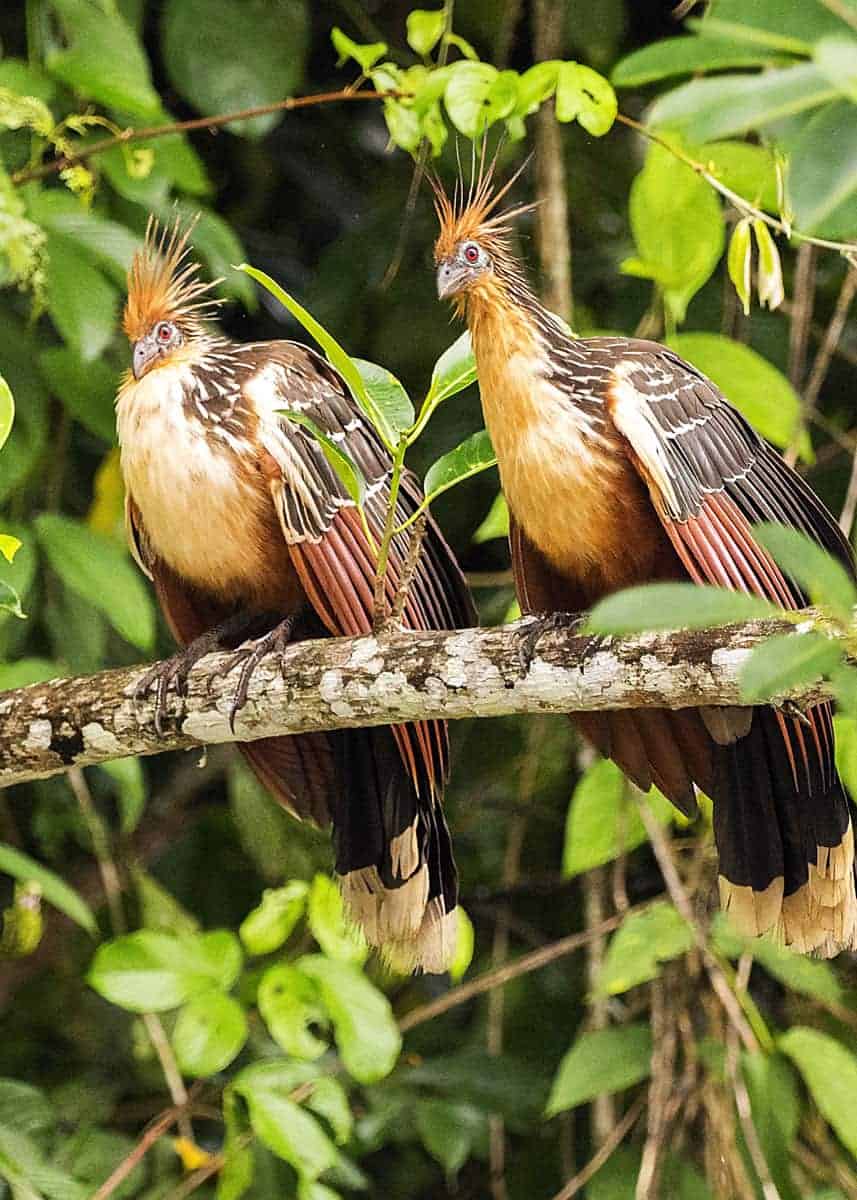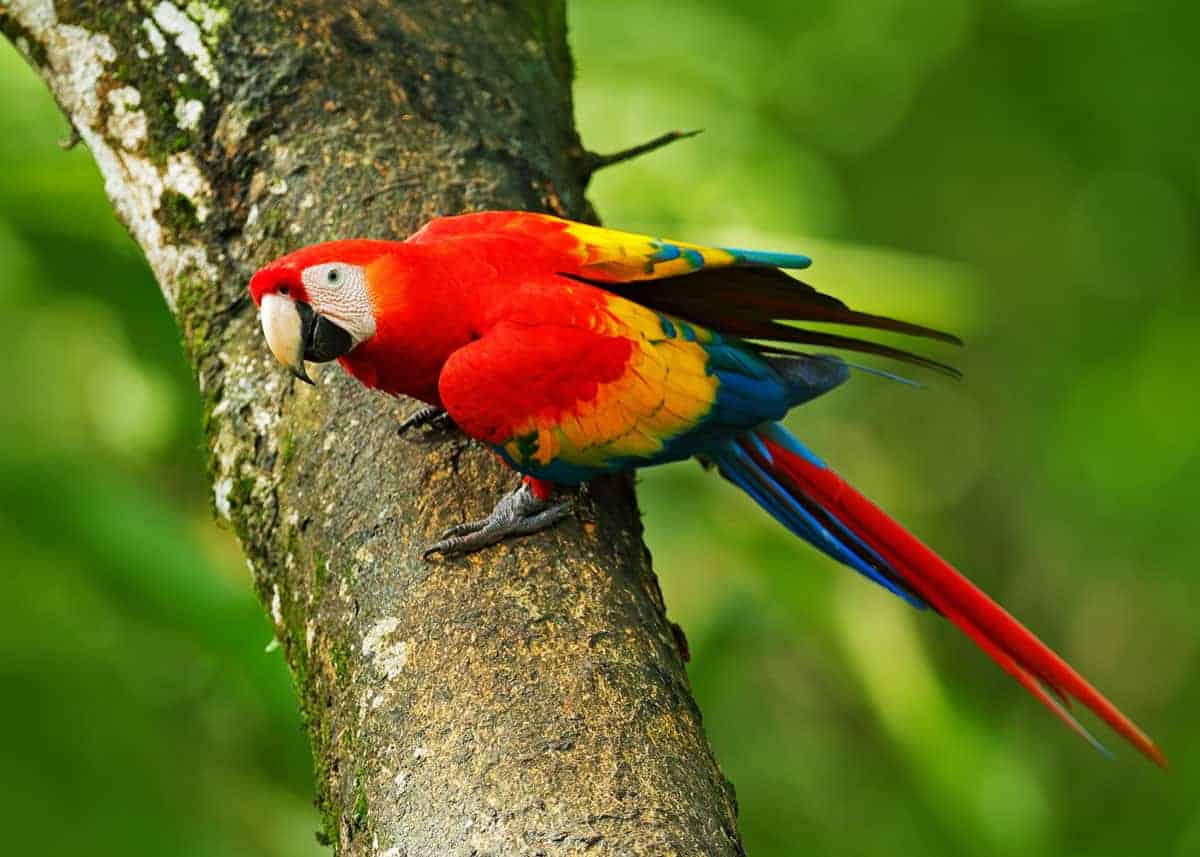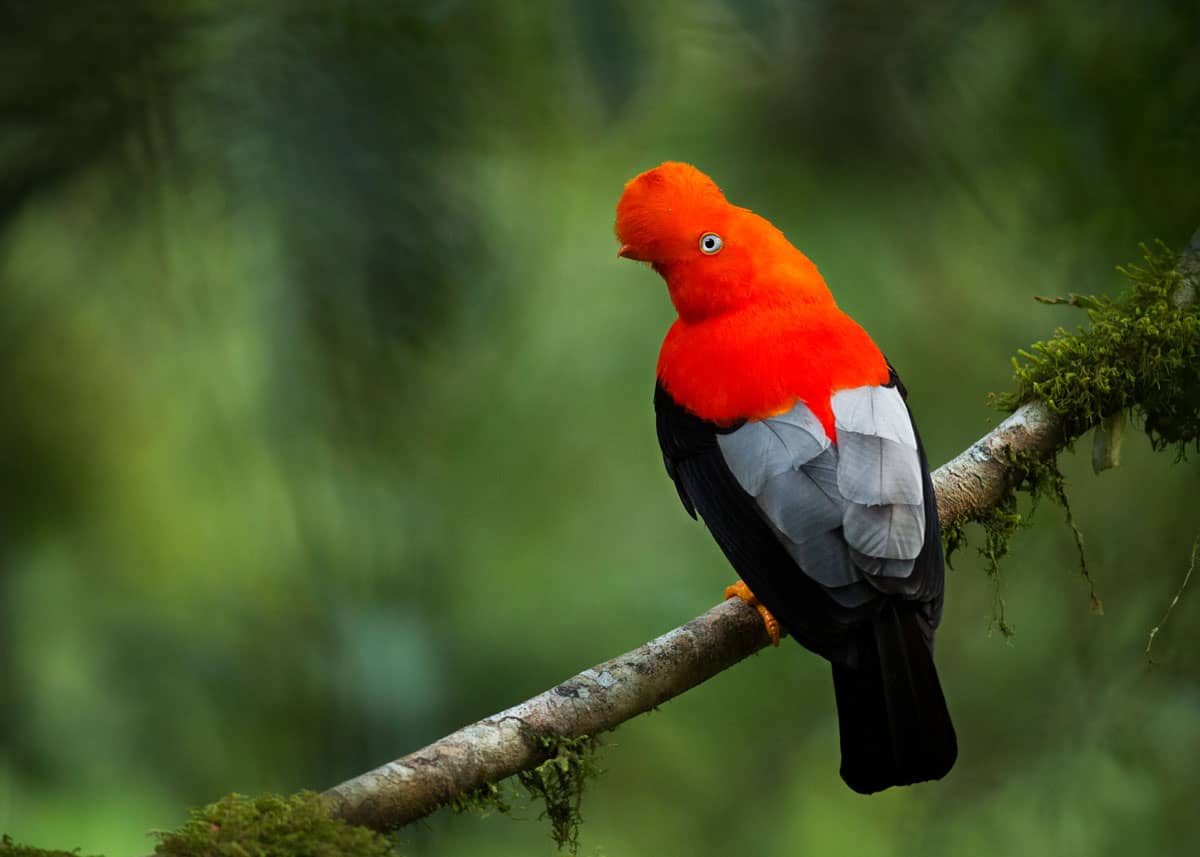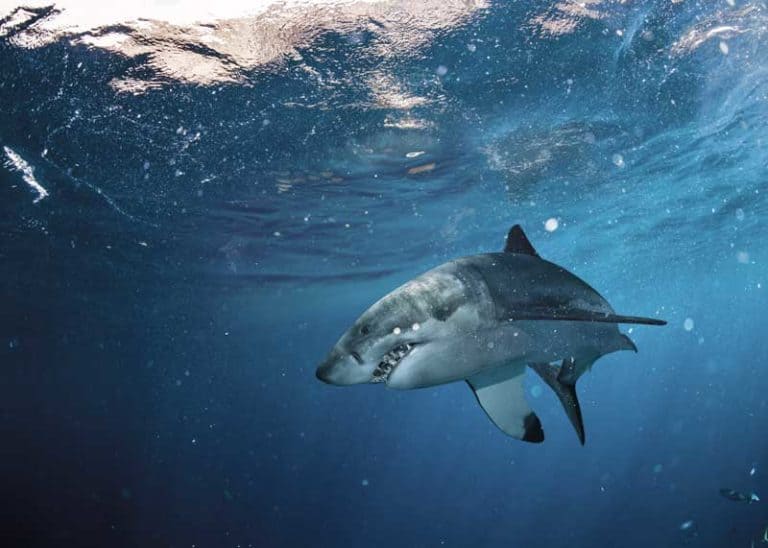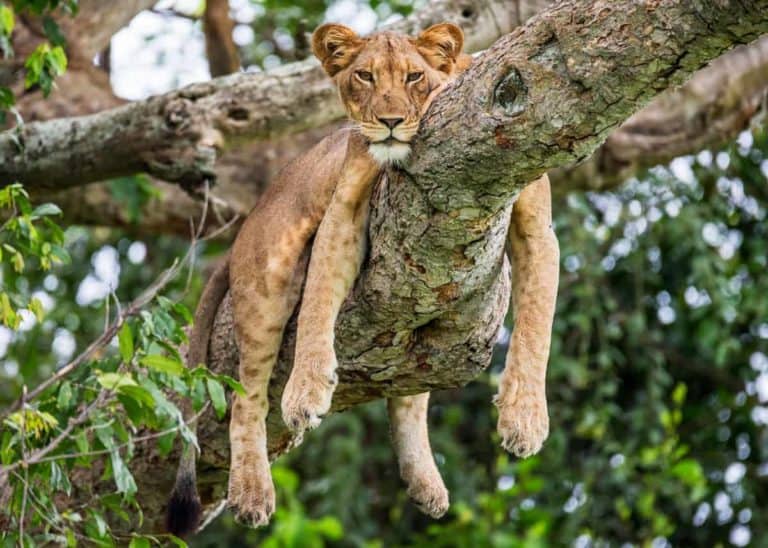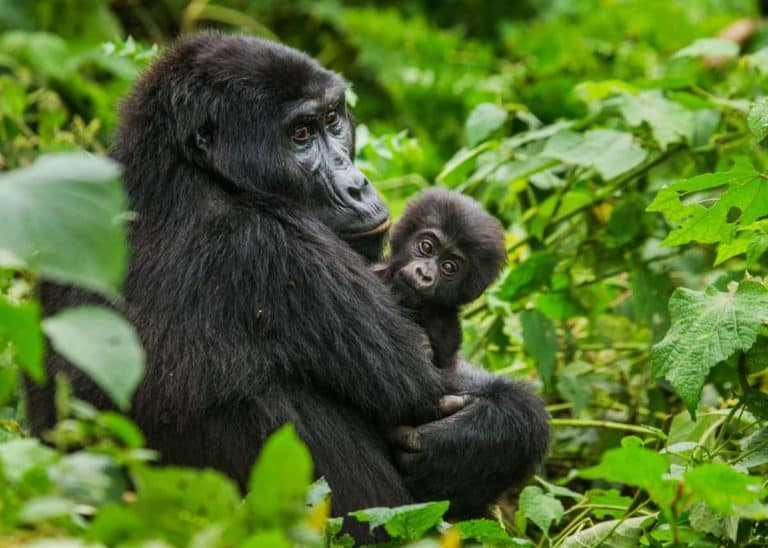47 Amazon Rainforest Animals (Ecuador’s Monkeys, Birds, Fish, Reptiles, Mammals, Amphibians…)
The rainforest is home to amazing (and often giant) animals. In this epic guide to rainforest animals, you’ll learn all about monkeys, birds, insects, mammals, fish and other animals from Ecuador’s Amazon rainforest. Each animal includes unique features, sizes, and specific facts.
Travel tip: If you’re traveling to the Amazon rainforest, you should bring a camera with a good zoom and a decent pair of binoculars. This will increase the odds of spotting and shooting some of the incredible animals.
47 Amazon Rainforest Animals
To organize this guide, the rainforest animals are divided into the following categories: monkeys, other mammals, reptiles, amphibians, fish, insects, and birds.
8 Amazon Rainforests Monkeys
1. Howler Monkeys
- Latin name: Alouatta
- Unique feature: Long, gripping tail and extremely loud call
- Head and body: 22 to 36 inches (56 to 91 cm)
- Tail: 23 to 36 inches (58 to 91 cm);
- Weight: 6.6 to 20 pounds (3 to 9 kg)
- Diet: Fruit, nuts, seeds, leaves
If you’re ever on a rainforest tour in Ecuador, you’re likely to hear the howler monkeys because howling is what they do best. Often at dawn and dusk, these rainforest animals ring out a concert of booming calls that can be heard up to three miles away.
It is believed that howler monkeys boast the loudest call of all the world’s primates.
Males are black or red while females are blonde, but all howler monkeys have a beard, thick fur and a long tail that they use as an extra limb to grasp and hang onto tree branches. They rarely come down to the ground because they spend most of their time eating, grooming and sleeping in the trees.
Howler monkeys move around in troops of about 18 to 20 members, searching for tree sites bearing abundant fruit.
Males howl to warn other troops of their presence and will fight to defend their troop if necessary. Females usually give birth every two years to one offspring after a 6-month gestation period.
Howler monkeys can live up to 20 years in the wild, but due to habitat loss, they are finding it more difficult to locate the food they need for survival.
2. Squirrel Monkey
- Latin name: Saimiri
- Unique features: Long tail, excellent eyesight and high intelligence
- Height: 9.8 to 14 inches (25 to 35 cm)
- Weight: 1.7 to 2.4 pounds (0.77 to 1.08 kg)
- Diet: Fruit, flowers, insects
Check our full guide to squirrel monkeys.
The squirrel monkey may be a little fellow climbing from tree to tree in the dense jungle of Ecuador, but it’s also one of the world’s most intelligent primates. In fact, it has one of the largest brain-to-body mass ratios among all monkey species.
In contrast to its short, olive-gray fur, the squirrel monkey has a white face, a brown muzzle, and a tuft of dark hair on its forehead. The most distinctive feature is the slender tail which is longer than its body size. The monkey uses its tail for balance when climbing through the trees.
Squirrel monkeys are sociable and move about in large troops of 40 or 50 members, but they tend to stay in the middle of the forest canopy to avoid being taken as prey by birds in the treetops or by land predators.
They have excellent eyesight that allows them to spot fruits in the dense vegetation as well as nimble hands and fingers that enable them to hold and peel fruit before eating it.
They also possess a peculiar habit of spreading urine on their feet and hands as a way of leaving a scented trail through the trees to mark their territory occupation.
3. Pygmy Marmosets
- Latin name: Cebuella pygmaea
- Unique feature: World’s smallest monkey
- Height: 5.5 to 6.3in (14 to 16 cm)
- Weight: 4.2 to 4.9 ounces (120 to 140 g)
- Diet: Fruit, tree sap, insects, spiders
Check out our full guide to pygmy marmosets.
The world’s smallest monkey species, the pygmy marmoset is tiny but full of character. Its fur is streaked with colors of gray, brown, green, black and white to help it stay hidden in the trees from predators.
A long tail, sharp claws and low weight all help the pygmy marmoset to climb and jump through the branches in search of fruit, berries, insects and small reptiles for food.
These miniature monkeys live in troops that are led by a dominant male and include multiple females with their offspring.
Females usually give birth to one or two babies at a time, and the males often carry the newborns on their backs until they are old enough to get around on their own.
Pygmy marmosets are becoming an increasingly popular exotic pet, but this is an unfortunate situation because these monkeys don’t thrive well away from their troop families.
They can die of depression or will attack their owners by biting them or even throwing feces at them. Even though they look cute, it’s best to let them live in the wild.
4. Capuchin Monkeys
- Latin name: Cebinae
- Unique features: They make tools and their own insect repellent.
- Size: Height: 12 to 22 inches (30 to 56 cm); Weight: 2 to 3 lbs (0.9 to 1.4 kg)
- Diet: Fruits, nuts, seeds, flowers, insects, spiders, bird eggs, small vertebrates, crabs and shellfish
Chances are that you’ve seen capuchin monkeys even if you’ve never been to the South American jungle. These playful and mischievous monkeys have appeared in TV shows and movies.
They are well noted for their antics, intelligence and ability to learn skills and tricks. They’ve even developed the ability to make and use tools (rocks and sticks) for flushing out termites and cracking open nuts and shellfish.
In the wild, these monkeys bond with one another by poking each other’s eyes. To win the attention of a potential mate, they throw rocks at him/her. They’ve also learned to protect themselves against mosquitoes by rubbing crushed millipedes on their bodies as a homemade repellent.
Named after the Capuchin friars because of the dark fur cap on their heads and their contrasting dark bodies and pale faces, these monkeys spend most of their time in the trees, sleeping, grooming and eating.
Family life is important to them, and they travel together in groups that include a lead male, females, and youngsters that stay with their mothers between four and eight years.
5. Spix’s Night Monkey
- Latin name: Aotus vociferans
- Unique feature: World’s only nocturnal monkeys
- Size: Height: 20 inches (50 cm); Weight: 2.20 lbs (1 kg)
- Diet: Fruits, leaves, insects
The Spix’s night monkey is part of the only nocturnal genus of monkeys in the New World. To accommodate their active nightlife, they have large brown eyes with excellent vision even though they are color blind.
They have dark gray fur, yellow chests and distinctive, white-and-black face patterns. They also have very small ears and a long, bushy tail that helps them move quickly and easily through trees.
Sometimes called owl monkeys because of their large eyes and nocturnal lifestyle, these unusual rainforest animals rest in tree holes during the day. After dark, they stir up the night with their noisy chatter as they socialize with one another and feed on fruits, insects and leaves.
Spix’s night monkeys are territorial and use their scents to declare occupation of their current territory. They form monogamous pairs that mate for life.
Females give birth to one baby after four months gestation, and youngsters stay with their mothers for up to three years. These monkeys can live up to 11 years in the wild but are threatened by birds of prey, large snakes, and wild cats.
6. Monk Saki
- Latin name: Pithecia monachus
- Unique feature: Shaggy fur and shy personality
- Size: Length: 12 to 24 inches (30 to 60 cm); Weight: 2.3 to 4.7 pounds (1 to 2 kg); Tail length: 10 to 22 inches (25 to 55 cm)
- Diet: Fruits, berries, honey, leaves, rodents, small birds
About the size of a large, plump rabbit, the monk saki is an odd-looking monkey with long fur that is either black, red or gray. Its face is paler in color with naked skin outlining the eyes. It also has a long, fluffy tail.
This species lives in the trees, usually running on all four limbs and jumping long distances. When it sleeps at night in tree branches, it curls up like a house cat.
Monk saki monkeys are known to be shy and cautious animals that travel together in family groups. They communicate with one another with bird-like twitters and screeches but will roar loudly to warn off other rainforest animals from their territory.
These monkeys form lifelong pairs and will mate at any time of the year. Females give birth to one baby after about six months of gestation. Babies may remain with their mothers until maturity which can be up to three years. The life expectancy for monk saki monkeys is up to 14 years in the wild.
7. White-bellied Spider Monkey
- Latin name: Ateles belzebuth
- Unique feature: Triangular patch on forehead
- Size: Length: 3.8 to 4.3 feet (1.16 to 1.31 m); Weight: 17 to 19 pounds (7.7 to 8.6 kg)
- Diet: Ripe fruits
Like other spider monkeys, this white-bellied species sails and swings through the Ecuadorian rainforest like a trapeze artist. It has a long, gripping tail and arms and legs that are longer than its body.
This monkey uses its long limbs, tail, and fingers to grasp tree branches and maneuver through the canopy. But, what sets this monkey apart from other spider monkeys is a white front side and a triangular patch of fur on its forehead.
Because white-bellied spider monkeys prefer eating ripe fruit, they benefit their ecosystem by dispersing seeds. Like other monkeys, they live in troops, but the females like to visit other groups and sometimes even move in with them. These spider monkeys are usually not aggressive toward one another, but they do respect a hierarchy system.
As far as mating goes, these monkeys are not monogamous. Females initiate copulation and will mate with multiple males. The females also provide most of the care for their offspring which they deliver after seven months of gestation. Juveniles remain with their mothers for about 17 months.
Spider monkeys have very long tails. Which land animal has the longest tail?
8. Brown Woolly Monkey
- Latin name: Lagothrix lagotricha
- Unique features: Large, round head and a strong prehensile tail
- Size: Length: 20 to 24 inches (50 to 60 cm); Weight: 11 to 18 pounds (5 to 8 kg)
- Diet: Fruit, seeds, insects
Brown woolly monkeys are….well, woolly and brown. They are fairly large monkeys with a stocky build and a large, round head. They also have a strong prehensile tail that is used to grip tree branches to allow more freedom for their hands as they make their way through the jungle trees.
Just like the other monkeys on this list, brown woolly monkeys travel together in groups but will often split up into smaller groups when foraging.
Their primary food is fruit, seeds, nuts and flowers, but they will also eat insects and small reptiles and rodents.
Because they are larger than other Ecuadorian monkeys, brown woolly monkeys have fewer predators. However, they are vulnerable to wildcats and humans who hunt them for their meat and fur.
Due to this fact and habitat loss from deforestation, the brown woolly monkey population numbers have drastically decreased, putting the species at risk for extinction.
12 Rainforest Mammals
9. Peccary (Javelina)
- Latin name: Tayassuidae
- Unique features: Razor-sharp tusks and scent glands under the eyes
- Size: Length: 3 to 4 feet (90 to 130 cm); Weight: 44 to 88 pounds (20 to 40 kg)
- Diet: Grass, seeds, roots, fruit, prickly pear cactus, small animals
One glance at a peccary, and you may think it’s a small pig. It does have a shape and snout like a pig, but there is no actual relation.
The peccary is sometimes called by its Spanish name, javelina (“spear”), because of its razor-sharp tusks that are shorter and straighter than pigs. It also has strong jaws that are used for crushing seeds, cacti, and plant roots. The peccary has scent glands on its back and beneath each of its small eyes that are used to mark its territory.
Peccaries live in herds in desert areas or canyons where there are vegetation and water nearby. They rub each other with their scent glands so that they recognize one another.
They usually only feed in the evenings and mornings, resting during the day in caves or brush bedding grounds.
Only the dominant males usually mate with the females. When ready to give birth, the females retreat to a maternal den in a hollow log to protect her one to three babies from predators. Juveniles are sexually mature at about 14 months old. Peccaries live up to 10 years in the wild.
10. Giant Otter
- Latin name: Pteronura brasiliensis
- Unique feature: World’s largest otter
- Size: Length: 3.25 to 4.5 feet (1 to 1.4 m); Tail length: 18 to 26 inches (45 to 65 cm); Weight: 49 to 71 pounds (22 to 32 kgs)
- Diet: Fish, crabs, small caimans, small anacondas
Considered the world’s largest otter, the giant otter grows up to 4.5 feet (1.4 m), and its long tail adds another couple of feet to its overall length.
At home in the lakes and rivers of the South American rainforest, this otter is well-suited for aquatic life. It has water-repellent fur, short webbed toes, and ears that close underwater.
The giant otter uses its keen eyesight and sharp claws to hunt and kill prey that include fish, crabs, and small anacondas and caimans.
It can eat up to to 10 pounds (4.5 kg) of food each day. It swims in family groups of 4 to 10 members and makes its nest on the banks of slow-moving rivers where the younger otters are safer.
Female giant otters give birth to 2 to 6 pups in an underground den after a two-month gestation period. The adults teach the pups to swim when they are between 2 and 3 months old. However, the pups won’t be ready to defend themselves until they’re about 3 years old.
11. South American Tapir
- Latin name: Tapirus terrestris
- Unique feature: Long snout
- Size: Length: 5.5 to 6.5 feet (1.7 to 2 m); Weight: 440 to 550 pounds (200 to 250 kg)
- Diet: Leaves, flowers, small tree branches, grasses, fruit, aquatic plants
The largest surviving land mammal native to the Amazon, the South American tapir is a dark brown or gray animal that makes you think of an anteater because of its long snout. However, it is more related to horses and rhinoceroses.
It stands between 30 and 43 inches (77 to 108 cm) high at the shoulders and weighs around 500 pounds (225 kg). It has a short, stubby tail and a dark, bristly main that runs along the crest and down the back of the neck.
This tapir is a shy creature that lives near water. It moves quickly on land but is also an excellent swimmer and diver. In fact, this tapir will retreat into the water whenever it feels threatened by predators like jaguars and cougars. Large caiman presents a threat in the water.
The South American tapir uses its strong snout to tear and feed on grasses, fruits, aquatic plants and tree branches. The female gives birth every two years. Population numbers for this species have declined due to hunters poaching for its meat and hide. It is now listed as vulnerable on the IUCN Red List.
12. Puma
- Latin name: Felis concolor
- Unique features: Unable to roar but can leap up to 20 feet high
- Size: Height: 43 to 78.7 inches (1.1 to 2m); Weight: 148 to 231.5 pounds (67 to 105 kg)
- Diet: Rats, sheep, deer, hares, peccaries, wild turkey
Also known as the cougar and mountain lion, the puma is one of the largest rainforest animals and ranks near the top of the food chain. Featuring a solid coat of brown/tan/gray, it resembles a large domestic cat, but don’t make the mistake of thinking of it as one.
Living in mountainous regions, this shy, elusive creature is an extremely powerful predator with with massive paws and muscular hind legs that enable it to leap nearly 20 feet high and outrun most other animals. It also has strong jaws and sharp teeth that can cut into the meat and tendons of its prey which is most often deer but sometimes rats, hares and peccaries.
A solitary animal, the puma usually only pairs up long enough to mate. An adult female will give birth once every two to three years to a litter of cubs that are born spotted and blind.
The puma is unique from all other big cats because it’s unable to roar. However, it can hiss, growl and purr just like any other cat.
13. Ocelot
- Latin name: Leopardus pardalis
- Unique features: Beautiful fur coat with an intricate pattern
- Size: Length: 22 to 40 inches (55 to 100 cm); Weight: 25 to 35 pounds (11.5 to 16 kg)
- Diet: Lizards, rodents, rabbits, small deer, fish, crabs, snakes
Ancient cultures in pre-Columbian South America once regarded the ocelot as a sacred animal.
In the 20th century, the ocelot almost went extinct due to excessive hunting. What’s so special about the ocelot? Well, it’s a beautiful fur coat, of course. Also known as the painted leopard, this small wildcat sports a velvety, yellow coat that is intricately patterned with black stripes, spots, and rosettes.
Adding to its beauty, the ocelot is also strong and agile. It can even swim well because it’s not afraid of water like many other cats.
Although it usually prefers the dense jungle, the ocelot is quite adaptable to a variety of habitats. It’s a secretive animal that sleeps by day in a high tree branch and goes out hunting at night for rodents, rabbits, fish, crabs, and lizards as well as the occasional monkey.
The ocelot breeds at any time during the year and gives birth to 2 to 3 kittens per litter in a tree hollow or rock crevice. The youngsters often remain with their mother for up to two years before establishing their own territory.
14. Brown-throated Sloth
- Latin name: Bradypus variegatus
- Unique features: Moves extremely slow
- Size: Length: 17 to 31 inches (42 to 80 cm); Weight: 5 to 13.9 pounds (2.25 to 6.3 kg)
- Diet: Rainforest leaves
Along with other sloth species, the brown-throated sloth is one of the most interesting and unique rainforest animals of Ecuador. It is well known for its extremely slow movement which actually benefits the sloth because nearby predators are usually looking for fast-moving prey.
Even the sloth’s digestive system is the slowest of any other mammal. It takes this sloth a whole two weeks to digest a single meal.
This grayish-brown sloth is named for the brown patch around its throat. Its long fur grows in an upside-down direction because the sloth spends most of its time hanging upside down in the treetops.
The sloth also has long, sharp claws that it uses to grip onto tree branches. But, these claws make it difficult for the sloth to get around on the ground when it comes down from the canopy once a week to urinate and defecate.
Did you know that this sloth’s fur is an ecosystem? Algae, fungi, and moth larvae all live in the sloth’s fur which in turn protects the sloth from disease-carrying parasites.
15. South American Jaguar
- Latin name: Panthera onca
- Unique feature: South America’s largest cat
- Size: Length: 43 to 75 inches (1.1 to 1.9 m); Weight: 79 to 350 pounds (36 to 160 kg)
- Diet: peccaries, anacondas, capybaras, deer, caiman, tapirs
The largest cat on the South American continent, this jaguar is also the third-largest cat in the world behind the lion and tiger. The South American jaguar is covered in a tan or yellow fur that is dotted with dark spots and rosetta patterns that camouflage the cat in the dense jungle.
The jaguar has a solid, muscular body with a broad head and strong jaws that deliver the most powerful bite of all the world’s big wildcats.
The South American jaguar is a solitary animal that spends its time resting in trees during the day and hunting at night. A fast runner, the jaguar climbs, swims and leaps well when pursuing prey.
This jaguar itself has no predators except for humans who have hunted it for its fur. Habit loss due to deforestation has also decreased the jaguar’s population numbers.
Here are the differences between a panther and a jaguar.
16. Giant Armadillo
- Latin name: Priodontes maximus
- Unique feature: World’s largest armadillo
- Size: Length: 30 to 39 inches (75 to 100 cm); Weight: 41 to 72 pounds (18.7 to 32.5 kg)
- Diet: termites, ants, worms, spiders, snakes, plants
Meaning “little armored one” in Spanish, the word armadillo describes the tough shell of thorny scales and multiple hinged bands that protect this odd mammal.
But, this armadillo is far from being little. In fact, it’s the largest of the world’s living armadillo species. Another interesting feature about this armadillo is that it has between 80 and 100 teeth which are the most of any land mammal.
The giant armadillo prefers being alone except during mating season. It hides in large burrows by day and comes out at night to feed. It especially loves eating termites and can devour an entire termite mound.
Although the giant armadillo is protected by law, it is still hunted for trade on the black market and for food. One giant armadillo provides ample meat and protein for many indigenous people in South America.
17. Capybara
- Latin name: Hydrochoerus hydrochaeris
- Unique feature: World’s largest rodent
- Size: Length: 39 to 51 inches (100 to 130 cm); Weight: 66 to 154 pounds (30 to 70 kg)
- Diet: Grasses, aquatic plants, fruits, berries, soft tree bark
Closely related to guinea pigs and chinchillas, the capybara is the world’s largest rodent. It’s a semi-aquatic animal that never strays too far from freshwater and is often found in marshes, swamps, lakes, and rivers.
Because of its amphibious lifestyle, the capybara features many traits that help it adapt well in water such as the webbed skin between its toes.
Plus, its eyes, ears, and nostrils are all positioned on top of its head so that it can submerge most of its body underwater when trying to avoid predators. Moreover, the capybara can hold its breath up to five minutes underwater.
Sociable, gentle, and non-aggressive, capybaras live in family groups that include a dominant male and multiple females and their offspring.
During the day, they doze in the safety of thickets or wallow in the mud. At evening, they venture out onto land to feed on grasses, fruits, and berries.
Although their population numbers aren’t under threat, capybaras are a source of food for many predators such as wildcats, caimans, birds of prey, snakes, and humans.
18. Common Vampire Bat
- Latin name: Desmodontinae
- Unique features: They have heat sensors and survive only on blood.
- Size: Height: 2.75 to 3.75 inches (7 to 9.5 cm); Weight: 0.7 to 2 ounces (19 to 57 g); Wingspan: 5.9 to 7 inches (15 to 18 cm)
- Diet: Blood
Learn more about vampire bats.
There are only three species of vampire bats in the whole world, and they are the only mammals that survive by feeding only on blood.
The vampire bat is among the smallest rainforest animals in Ecuador. It’s the size of a human adult thumb with dark brown fur and wings. It usually feeds on the blood of birds or sleeping livestock animals.
Although it is rare, it can bite a human. A single vampire bat bite only consumes a tiny bit of blood, but it can transmit diseases.
Vampire bats have sensors on their noses that detect heat and direct them to a food host. They also use echolocation to determine their surroundings. What’s more, they also have thumbs, wrists and legs that help them navigate on flat surfaces.
Vampire bats live either in small groups or large colonies, roosting in dark places such as caves, abandoned buildings, and hollow trees. They must feed at least every two days or they will die. If some individuals don’t get enough blood, other group members will regurgitate some for them.
19. Amazon River Dolphin
- Latin name: Inia geoffrensis
- Unique feature: Pink in color
- Size: Length: 72 to 98 inches (2 to 2.5 m); Weight: 220 to 440 pounds (100 to 200 kg)
- Diet: Fish, piranhas, river turtles, frogs, freshwater crabs
Also known as the pink river dolphin, the Amazon River dolphin grows up to 8 feet and is best known for its pink coloring.
As a youngster, this dolphin is gray, but as it grows older, sunlight and diet lighten its color to a white or pink shade. When this river dolphin is excited or surprised, it will blush a bright shade of pink just like many humans.
Amazon river dolphins are agile and can swim forward or backward with just one flipper. They also swim on their backs. Unlike their saltwater relatives, they can move their necks from left to right. Also contrary to other dolphins that swim in pods, these pink river dolphins are seen either alone or in small groups of two to four individuals.
Pink river dolphins are very intelligent animals and even have a brain capacity that’s 40% larger than humans. They are friendly to humans and have been known to help push swimmers to shore.
Unfortunately, their friendliness and curiosity sometimes cause them injury when they approach motorized boats and come into contact with propellers.
Learn about the 12 Longest South American Rivers
20. Amazonian Manatee
- Latin name: Trichechus inunguis
- Unique feature: Constantly regrows molar teeth
- Size: Length: Up to 9.5 feet (2.9 m); Weight: 920 pounds (417 kg)
- Diet: Aquatic plants
The smallest of all the world’s living manatees, the Amazon manatee is the only species that live exclusively in freshwater. It never leaves the water but must come to the surface to breathe.
Growing nearly 10 feet long (2.9 m) and weighing up to 920 pounds (417 kg), this manatee is described as a “sea cow” with brownish-gray, wrinkled skin and whiskers around its upper and lower lips. It also has a unique trait where it constantly regrows molar teeth when they wear down.
Amazonian manatees are shy animals that live in groups of 4 to 8 members in the murky waters of lagoons and rivers, feeding on aquatic plants.
During the rainy season of Ecuador, they migrate to flooded forest areas where food is abundant but retreat to the deeper waters during the dry season where they sometimes will fast for lack of food.
Amazonian manatee births usually occur in January in Ecuador. Females are pregnant for a whole year before delivering underwater. Newborns can swim and suckle their mothers underwater but must go to the surface to breathe. Amazonian manatees can live up to 12 years.
10 Rainforest Reptiles
21. Black Caiman
- Latin name: Melanosuchus niger
- Unique features: Large reptile with excellent eyesight and hearing
- Size: Length: 7.3 to 14.1 inches (2.2 to 4.3 m); Weight: 209 to 660 pounds (95 to 300 kg)
- Diet: Fish (catfish and piranha), turtles, capybaras, cats, dogs, deer
Check out our full guide to black caimans.
Closely related to alligators, the black caiman is a large reptile that grows up to 14 feet (4 m) although some have measured up to 16 feet (5 m).
It is brownish-black or totally black with scales, a long narrow snout, and a bony ridge above the eyes. It also has a long, flat tail that it uses for swimming and defense against predators.
Black caimans live in slow-moving water such as swamps and mangroves. They have excellent eyesight and hearing as well as strong molar teeth for crushing fish and small reptiles and mammals. They are important to their habitat because they prevent the overpopulation of their prey.
When they aren’t feeding and swimming up to 30 mph, they like to bask in the sun. They mate during the dry season when food is plentiful.
Females lay up to 65 eggs in a large mound in the ground which they guard until hatched. The temperature will determine the sex of the offspring, with higher temperatures associated with males. After hatching, the mother teaches her young how to swim.
22. American Crocodile
- Latin name: Crocodylus acutus
- Unique feature: Captures prey with a “death roll”
- Size: Length: 9.6 to 13.5 feet (2.9 to 4.1 m); Weight: Up to 880 pounds (400 kg)
- Diet: Fish, birds, reptiles, small mammals, occasionally cattle or deer
A large lizard-like creature with short legs and a long, muscular tail, the American crocodile is dark olive-brown with darker bands running across its body and tail. Unlike the alligator, this crocodile has a long, triangular snout and an exposed fourth tooth.
The American crocodile lives in saltwater habitats, feeding primarily on fish but also turtles, crustaceans and the occasional bird or mammal.
It captures its prey in a unique maneuver called a “death roll.” First, it remains motionless in the water until a fish or animal comes close enough to grab it quickly. Then, it takes the animal underwater and rolls with it over and over until it drowns its prey.
American crocodiles can survive for long periods between feedings. They also have hearts and brains that are more developed than any other living reptile.
Females initiate courtship, but they must go about it with careful flirtations to ease the male’s anger after invading his territory. These crocodiles are protected against hunting, but they are still threatened by habitat loss and human population.
23. Spectacled Caiman
- Latin name: Caiman crocodilus
- Unique feature: Looks like it’s wearing eye spectacles
- Size: Length: 5.9 to 6.6 feet (1.8 to 2 m); Weight: 15 to 88 pounds (7 to 40 kg)
- Diet: Fish, amphibians, reptiles, water birds, wild pigs
Check out our full guide to spectacled caiman.
This greenish-gray caiman species gets its name from the bony ridge between its eyes that gives it the appearance of wearing spectacles. Although it prefers slow-moving water areas, this caiman is adaptable to most wetland habitats and can tolerate both freshwater and saltwater.
The average spectacled caiman eats a variety of crustaceans, fish, insects and small reptiles, but larger ones will take water birds and mammals such as wild pigs that come near the water to drink. Researchers have noted that these caimans may stop feeding or resort to cannibalism during dry conditions when food is scarce.
Female spectacled caimans often share nests as a way of increasing the survival of their offspring. Sometimes, they will even elect a nanny caiman to babysit over the whole group of youngsters. However, most mothers will remain close by to protect their nests against predators.
24. Green Anaconda
- Latin name: Eunectes murinus
- Unique feature: World’s heaviest snake
- Size: Length: Up to 17.1 feet (5.21 m); Weight: 66 to 154 pounds (30 to 70 kg)
- Diet: Birds, fish, amphibians, mammals, other reptiles
It may come in second place as the world’s longest snake after the reticulated python, but the green anaconda takes the award for the heaviest snake in the world, weighing up to a whopping 550 pounds (250 kg). This hefty anaconda is dark olive green with a yellow belly and big, brown blotches on the back.
It has a forked tongue that it uses to detect its environment, but it also uses vibrations to determine its surroundings. The green anaconda spends most of its time in the water of rainforest swamps and marshes. Its eyes and snout are on top of its head so that it can stay submerged most of the time.
The green anaconda is an opportunistic eater that feeds on a variety of prey such as birds, fish, mammals, amphibians and other reptiles. It kills its prey by coiling its body around the victim, constricting blood and oxygen supply until it dies.
When feeding, the jaws of the green anaconda will completely disconnect to allow the snake to swallow its prey. A green anaconda female gives birth to between 20 and 40 babies after they’ve hatched from eggs while still inside her.
25. Emerald Tree Boa (Both Species)
- Latin name: Corallus caninus and corallus batesii (2 species)
- Unique feature: Emerald green with white zig-zag markings
- Size: Length: 5 to 6.5 feet (1.5 to 2 m); Weight: 0.71 to 1.75 ounces (20 to 50 g)
- Diet: Lizards, frogs, small birds and mammals such as rats and bats
Check out our full guide to both species of the emerald tree boa.
The emerald tree boa is a bright green, non-venomous boa species with distinctive white “zig-zag” markings down its body. It grows to about 6 feet (1.8 m) and has a prehensile tail that helps it slither around in the rainforest trees where it spends most of its day coiled over a branch.
At night, the emerald tree boa uses its vertical pupils to sense movement, and its heat receptors (around the mouth) to detect prey.
This snake is an ambush predator that patiently waits for birds, lizards, frogs, and bats to come nearby and then quickly strikes to grasp the victim with its long, front teeth. Once the snake captures its prey, it will then constrict the life from it before swallowing it.
Females give birth to between 10 and 20 live newborns after they hatch from eggs within her body. The babies are orange to brick-red in color but gradually change to the mature emerald green over a 12-month period.
26. Red-tailed Boa
- Latin name: Boa constrictor
- Unique feature: Has pelvic spurs
- Size: Length: 3 to 13 ft (0.91 to 3.96 m); Weight: 22 to 33 pounds (10 to 15 kg)
- Diet: Rodents, lizards, bats, amphibians, small birds and mammals
Also known as the common boa or simply, boa constrictor, the red-tailed boa is a heavy, non-venomous snake that ranks among the longest in the world.
This boa is noted by the dark saddle markings that run along its body. Sometimes, it may also have spots. There is also a thin, dark stripe on the head and dark triangles in front of each eye.
This snake also has small, hooked front teeth that it uses to capture and control prey. The boa then wraps its body around its victim and kills it by constricting its blood and air. After a large meal (such as a rodent), the boa may not require feeding again for weeks.
The red-tailed boa also has distinctive claws on its underbelly known as pelvic spurs. These spurs are used both in combat and courtship.
Because boa constrictors feed mainly on rats and mice, they help prevent and control the diseases often carried by rodents.
27. Bothrops Asper
- Latin name: Bothrops asper
- Unique feature: One of the most dangerous snakes in South America
- Size: Length: 3.9 to 5.9 feet (1.2 to 1.8 m); Weight: Up to 13 pounds (6 kg)
- Diet: Rats, rabbits, birds, frogs, geckos, lizards
Check out our huge guide to Bothrops asper
Of all the Ecuador rainforest animals, the Bothrops asper is not one that you want to stumble upon because it’s one of the most venomous snakes in South America. It happens to be the main cause of snakebite instances because it often lives near human habitations.
You can distinguish this dangerous snake by its brownish-black skin that is marked with patterns of gray, tan and cream colors. It also has a broad, flat head that sticks out apart from the rest of its body.
The female is significantly larger than the male with a longer and heavier body as well as a broader head and bigger fangs.
Bothrops aspers are usually found nearby streams and rivers where they bask in the sun or lie under the cover of leaf litter while waiting to ambush prey such as rodents, lizards, amphibians, and insects.
These snakes are unpredictable when disturbed. They may flee, or they may strike. Their venomous bites can cause severe swelling, sickness, infection, gangrene and death without antivenom treatment.
During mating season, males chase the females which mate with multiple partners. After a gestation period of 6 to 8 months, the females give birth to live young that can number up to 85 babies.
28. Basilisk (Jesus Christ lizard)
- Latin name: Basiliscus basiliscus
- Unique feature: Runs on the water surface
- Size: Length: 2.5 feet (76 cm); Weight: 4.8 to 6.8 ounces (135 to 194 g)
- Diet: flowers, insects, and small birds, fish, eggs and snakes
This lizard species is nicknamed the “Jesus Christ lizard” because it runs on the surface of the water. (Yes, it really does.) It usually treads water when it’s fleeing from a predator. It runs upright on its hind legs at a speed of 15 mph (24 km/h). Specialized folds on the basilisk’s feet also help it to paddle on the water.
Growing up to 2.5 feet (76 cm) in length, the basilisk is a lightweight lizard of olive/brown/cream colors with a distinctive crest on its back.
The male has additional crests on his head and tail. It has a wide mouth with saw-like teeth that it uses to eat prey such as dragonflies, fish and eggs. It’s also a great climber and swimmer with the ability to stay underwater for 30 minutes.
Female basilisks lay three to four clutches of 10 to 20 eggs per year. The mothers lay the eggs in a hole in the ground where they hatch after three months. Once they hatch, the babies are totally independent.
29. Giant South American River Turtle (Arrau)
- Latin name: Podocnemis expansa
- Unique feature: Largest freshwater turtle in Latin America
- Size: Length of carapace: 1.3 to 2.3 feet (40 to 71 cm); Weight: Up to 200 pounds (91 kg)
- Diet: Leaves, algae, seeds, fruit, freshwater sponges, eggs
Also known as the Arrau side-necked turtle, the giant South American river turtle is the largest freshwater turtle in Latin America as well as one of the largest in the world.
Reaching up to 200 pounds (91 kg) with a carapace length of up to 3.5 feet (1.07 cm), this turtle varies between gray, brown and olive colors depending upon how much algae is growing on its shell. The male is smaller than the female but has a longer tail.
These turtles live in deep freshwater lagoons, ponds, rivers and flooded forest, feeding on plants, seeds, fruits and freshwater sponges. They rarely come out of the water except to occasionally bask in the sun and lay eggs.
During breeding season, the females migrate in large groups to certain nesting sites (usually beaches) during the night. They lay between 50 and 150 eggs in a deep hole during the low water season. If left unharmed, the eggs hatch after 50 days, and the 2-inch babies make a mad dash for the water to avoid predators. These turtles can live up to 20 years in the wild.
30. Yellow-footed Tortoise (Brazilian Giant Tortoise)
- Latin name: Chelonoidis denticulata
- Unique feature: Among the largest tortoises on earth
- Size: Avg. Length: 15.75 inches (40 cm); Weight: 15 to 20 pounds (7 to 9 kg)
- Diet: Plants, grasses, fruit, mushrooms, snails, worms
One of the largest tortoise species on earth, the South American yellow-footed tortoise gets its name from the yellowish-orange scales on its legs. It can reach up to nearly 16 inches (40 cm) in length and weigh up to 20 pounds (9 kg).
Its carapace is a high-domed oval shape with dark brown and yellow markings. The male can be distinguished by its larger size, concave shell and longer tail.
These tortoises are usually found in dry, grassy habitats where they feed on grass, plants, mushrooms, fruits, snails and worms.
They communicate with one another with raspy, cooing sounds. Males make swinging movements with their heads to communicate with other males, but females do not make these movements at all.
Yellow-footed tortoises are not endangered, but they are hunted and collected in large numbers to be eaten as a delicacy. Because they are considered as “fish” by the Catholic Church, huge quantities of these tortoises are eaten during Holy Week.
3 Rainforest Amphibians
31. Poison Dart Frog
- Latin name: Dendrobatidae
- Unique features: Brightly colored and produces high levels of toxins
- Size: Length: 0.6 to 2.4 inches (1.5 to 6 cm); Weight: 0.07 to 0.25 ounces (2 to 7g)
- Diet: Insects, ants, spiders
Poison dart frogs may be small and visually appealing, but they rank among the world’s most dangerous creatures. These frogs excrete a toxin through their skin that warns all the other rainforest animals not to eat them. One lick could can cause sickness, paralysis and even death to potential predators.
These frogs get their name from the fact that indigenous tribes once coated their arrows and blow-darts with the frog’s poison to use in hunting.
There are nearly 200 hundred species of poison dart frogs. They all vary in size and colors, and it’s believed that the more colorful they are, the more poisonous. Scientists believe that diet is what creates the toxin in these frogs which includes insects like ants, termites, spiders and flies.
There frogs are poisonous but not venomous. Here’s the difference.
Poison dart frogs have a cute courtship ritual where the male sings to attract the female. Together, they rub noses and do a little dance. The male then leads the female to a leafy spot where she will lay up to 40 jelly-like eggs.
After the male fertilizes the eggs, he guards them and keeps them wet by sitting on them or urinating on them.
Once the tadpoles hatch, they swim up on Daddy’s back so that he can carry them to a shallow area of water to live and develop into mature frogs. Mom then brings the tadpoles unfertilized eggs to feed on.
32. Ecuadorian Poison Dart Frog
- Latin name: Ameerega bilinguis
- Unique features: Rainbow-colored and highly poisonous
- Size: Length: 0.81 to 1 inches (2 to 2.5 cm); Weight: Unknown
- Diet: Insects
The Ecuadorian poison frog looks like it hopped out of a rainbow. It’s a black poison dart frog splashed with multi colors of red, orange, yellow, blue and green. Like other poison dart frogs, this species excretes a toxin from its skin as a warning to predators.
Ecuadorian poison frogs live in leaf-litter near rivers, streams and marshes, feeding primarily on ants. Scientists believe it’s this diet that produces this frog’s toxin.
Males of this frog species are aggressive and territorial, but they charm the ladies with their courtship songs. They are also great fathers who carry their tadpoles on their backs to a pond or shallow body of water where they can continue to develop.
Sadly, these frogs are threatened by habitat loss.
33. Mutable Rain Frog
- Latin name: Pristimantis mutabilis
- Unique feature: Shapeshifting
- Size: Length: 0.67 to 0.91 inches (17 to 23 mm)
- Diet: Insects
Shapeshifters aren’t just a myth. They really do exist in the misty cloud forest of Ecuador’s Las Gralarias Reserve.
In 2006, scientists discovered the mutable rain frog, the first known amphibian that can morph its skin texture from smooth to spiny in mere minutes.
Barely larger than a human adult fingernail, this tiny brown/gray/green frog looks like a normal frog until it is disturbed. Then, its skin suddenly takes on a prickly appearance. Scientists still aren’t sure why the frog shapeshifts, but they believe the frog does this as a defense mechanism to blend in with the mossy environment in which it lives.
It’s guessed that the population numbers for this frog species are abundant in the location where it was found because many males can be heard calling out at night.
While there is still much to be learned about the mutable rain frog, it does have one very unique feature. It bypasses the tadpole stage and develops directly into frogs while still in their eggs.
5 Fish in Rainforest Rivers
34. Red-bellied Piranha
- Latin name: Pygocentrus nattereri
- Unique feature: Razor-sharp teeth
- Size: Length: 14 inches (35 cm); Weight: Up to 4 pounds (1.81 kg)
- Diet: Insects, worms, fish, crustaceans, plants
Red-bellied piranhas sometimes get a bad reputation for being ferocious predators, but this may not be entirely true.
Named for their red-colored bellies, these piranhas are also known for their strong jaws and razor-sharp teeth. They do travel in shoals of 20 or more members, but they do this more out of self-protection than as a gang of bullies.
These fish are primarily scavengers who prefer eating the tail fins from larger fish but also forage for plants, fish, crustaceans, worms, and insects. If food is scarce, they will enter into a feeding frenzy attack to prevent starvation, but this is rare.
Red-bellied piranhas prefer fast-moving whitewater but will also live in slower freshwater streams, lakes, and rivers. They travel together to defend themselves against predators such as caimans, dolphins, and larger fish.
During breeding cycles, females lay thousands of eggs that stick to submerged aquatic plants. Afterward, males will fertilize the eggs. Adults will then swim in circles around the nesting sites to guard the eggs which hatch after only about three days.
35. Candiru (Toothpick Fish)
- Latin name: Vandellia cirrhosa
- Unique feature: Tiny blood-sucking fish
- Size: Length: 1 to 1.97 inch (2.5 to 5 cm)
- Diet: Blood of other fish
Related to the catfish, the candiru is a parasitic fish that feeds on the blood of other fish by attaching itself to their inner gills. Because of its appetite for blood, it’s sometimes called the vampire fish. It’s also called the toothpick fish because it is really thin and grows only about two inches in length.
It’s difficult to see candiru because they are translucent and usually stay burrowed in the muddy riverbed. It has a slightly flat head, large black eyes, barbels, and backward-facing spines that keep it attached while feeding.
There have been tales rumored around the Internet of the candiru being attracted to human urine. These reports warn people not to urinate in the rivers because the candiru can enter a human’s urethra, causing pain and infection. However, a study done in 2001 proves these allegations to be false.
36. Arapaima Gigas (Pirarucu)
- Latin name: Arapaima gigas
- Unique feature: Huge fish that comes to the surface to breathe air
- Size: Length: Up to 14.76 feet 4.5 m); Weight: Up to 441 pounds (200 kg)
- Diet: Fish, crustaceans, frogs (birds near the water surface)
The arapaima gigas is one of the oldest and largest freshwater fish in the world, growing to nearly 15 feet (4.5 m) in length and weighing up to 441 pounds (200 kg). It has a sleek body with green/gray/red scales, a wide mouth, and a tongue that’s covered in sharp, bony teeth. The fish uses this tongue for crushing prey (other fish, crustaceans, frogs and water birds).
One of this fish’s most unique features is that it must breathe air. It inhabits flooded forests, swamps and river channels where the water is often oxygen-deficient, but it has gills to breathe underwater and primitive lungs to breath near the surface. The need to come up for air every 15 minutes makes the arapaima gigas an easy target for fishermen.
Between February and April, male and female arapaima gigas adults make a nest on the sandy river bottom. The female lays the eggs and the male fertilizes them. Afterward, the male fiercely guards the eggs while the female defends the territory against predators for about four or five days until the eggs hatch.
37. Payara (Vampire Fish)
- Latin name: Hydrolycus scomberoides
- Unique features: Long fangs
- Size: Length: Up to 4 feet (117 cm); Weight: Up to 40 pounds (18 kg)
- Diet: Other fish including piranhas
Read more about payaras (vampire fish)
Payaras are huge, scary-looking fish with two large fangs protruding from their lower, upturned mouths. Used to impale prey, these razor-sharp fangs are so long (up to 6 inches) that the fish’s upper jaw has two holes to accommodate them so that they don’t impale the payaras themselves.
These silver fish are part of the dogtooth tetra family and are sometimes called the vampire tetra and the sabertooth fish due to their fangs.
Found in fast-moving freshwater, payaras are aggressive predatory fish that travel in schools as they hunt for other fish that include piranhas. Because of their exciting fighting ability, they are a popular game fish for sports fishermen.
The reproduction habits of these fish are not well studied, but it is believed that they migrate long distances upstream from river channels to larger river areas during the onset of the rainy season to begin courtship and spawning rituals.
38. Electric Eels
- Latin name: Electrophorus electricus
- Unique feature: Produces electrical shock
- Size: Length: 8.22 feet (2.5m); Weight: 44 pound (20kg)
- Diet: Fish, birds and small mammals near the water
You sure don’t want to come into contact with one of these electric eels. They produce a 500-volt electrical shock that can severely injure large mammals, including humans. Fortunately, you aren’t likely to run up against one of these fish because they live on the muddy bottoms of stagnant swamps, creeks and floodplains.
Would you believe that the electric eel isn’t really an eel at all? It’s actually a knifefish that is closely related to the catfish. Dark-colored on the back with yellow/orange on the belly, this fish has a square mouth and no scales. It has organs in its abdomen that generate electricity used to defend itself and to stun prey before feeding.
The electric eel is nocturnal with poor eyesight, so it uses electricity as a sort of radar for navigation in dark, murky waters.
It displays unusual breeding habits where the male first build a nesting site on the riverbed with his saliva. The female then lays multiple batches of thousands of eggs each. Afterward, the male fertilizes and devotedly guards the eggs. Baby electric eels feed on the eggs that were spawned later.
3 Insects in the Amazon Rainforest
39. Bullet Ant
- Latin name: Paraponera clavata
- Unique features: Extremely painful sting
- Size: Length: Up to 1.2 inches (30 mm)
- Diet: Nectar and small arthropods
Trust me you’ll want to avoid coming into contact with the bullet ant, make sure to keep your distance. This long, reddish-black ant with a large head has a sting that’s considered the most painful of any insect.
In fact, it gets its name from the excruciating pain of being shot by a bullet. What’s even worse is that the pain doesn’t go away for 12 to 24 hours. Plus, the ant’s venom can also cause nausea, vomiting, uncontrollable shaking and temporary paralysis.
If you do happen to stumble upon a bullet ant colony (which is usually at the base of a tree trunk), at least this ant will give you a warning by emitting a strong odor. If the warning is ignored, watch out because it will try to come in for the sting.
Growing up to an inch or more in length, bullet ant workers are some of the largest ant workers in the world. They forage in the canopy foliage for nectar, tree sap and insect larvae which they carry back to the colony. Bullet ant soldiers guard the colony site against intruders while drones and the queen ant reproduce.
40. Blue Morpho Butterfly
- Latin name: Morpho menelaus
- Unique feature: Huge butterfly that appears to change colors
- Size: Length: 6 inches (15 cm); Wingspan: Up to 7.5 inches (20 cm)
- Diet: Fluids of tree sap, fermenting fruit, fungi
Learn more about all 24 species of blue morpho butterflies
If you ever get the chance to trek through the Amazon Basin to see some of Ecuador’s amazing rainforest animals, keep your eyes open for one of the most magical creatures of all: the blue morpho butterfly. It won’t be difficult to see one because this butterfly is bright blue and can be the size of an adult human hand.
One of the largest butterflies in the world, the blue morpho often flutters through the forest floor and shrubs searching for nectar, fermenting fruit, tree sap and fungi to eat. It’s called the “blue morpho” because it appears to morph while flying, but there are a couple of different reasons for this.
For one, the wings aren’t really blue at all. They just look that way due to the phenomenon of iridescence. Here are other animals that display iridescent colors.
Secondly, only the upper side of the wings appear blue. The underside is brown with eyespots so that when the blue morpho is flying, its wings appear to change from blue to brown. This camouflage trick enables the blue morpho to blend in with the surrounding foliage. By the way, only the males are blue. The females are entirely brown.
41. Scolopendra Gigantea (Amazonian Giant Centipede)
- Latin name: Scolopendra gigantea
- Unique feature: World’s largest centipede
- Size: Length: Up to 12 inches (30 cm)
- Diet: Small invertebrates such as worms, crickets, snails and roaches but also mice, frogs, lizards and small birds
Can you imagine a centipede large enough to eat a mouse or small bird? Well, that’s the Scolopendra gigantea, or in common words, the Amazon giant centipede. It’s also known as the Peruvian giant yellow-leg centipede.
It’s the largest centipede in the world, growing up to a foot (30 cm) in length. It has a reddish-brown body with about 23 body segments that are each attached to a pair of yellow legs (46 legs total). The first body segment has fangs that the centipede uses to inject venom into its prey.
Found in humid places such as beneath rocks and soil, these centipedes are nearly blind and depend on sensory receptors to navigate and detect prey. They creep around cave walls and on the ground until a victim happens by, and then they lunge at it and coil their bodies around it while delivering their lethal bite. Their venom kills most small animals and insects and can cause severe pain and sickness to a human.
In reproduction, males spin a silk pad with their sperm which the female then takes up to fertilize her eggs. The female buries her eggs in dirt holes and broods them until they hatch. After hatching, the babies go through a series of molts that develop each of their body segments and legs.
6 Rainforest Birds
42. Spectacled Owl
- Latin name: Pulsatrix perspicillata
- Unique feature: Wears “spectacles”
- Size: Length: 16.1 to 20.6 inches (41 to 52.3 cm); Weight: 1 to 2 pounds (453 to 906 g); Wingspan: 12 to 14 inches (30 to 36 cm)
- Diet: Insects, spiders, caterpillars, mice, bats, birds
The spectacled owl has big, yellow eyes with white eyebrows and white streaks between the eyes, making it look as though it’s wearing spectacles. This owl is a handsome bird with a chocolate-colored head, neck collar and upper parts that contrast with a cream-colored belly and throat.
A nocturnal bird, the spectacled owl dozes while staying hidden in tall trees by day. Come dusk, it wakes up and waits for prey (insects, mice, birds, and bats) to come into view before suddenly pouncing on it.
Male spectacled owls make a tapping or knocking sound when claiming territory while females sometimes shrill like a hawk.
These owls build their nests in tree hollows where the female lays and incubates one to two eggs for about five weeks. Both parents are dedicated to feeding and teaching their chicks for up to a year after hatching.
43. Harpy Eagle
- Latin name: Harpia harpyja
- Unique features: One of the world’s largest and most powerful raptors
- Size: Height: 35 to 41 inches (89 to 105); Weight: 8.5 to 20 pounds (3.8 to 9 kg); Wingspan: Up to 6.5 feet (2 m)
- Diet: Tree-dwelling mammals (sloths, monkeys, squirrels), birds, iguanas, snakes
Check out our full guide to Harpy eagles.
Because it’s rarely seen, you might think the harpy eagle is only a legend, but it is alive and inhabiting the forest treetops of Central and South America. In fact, it’s of one of the largest and most powerful raptors in the world.
If you do ever spot one of these eagles, you’ll be in awe over its size. It can weigh up to 20 pounds, have talons longer than grizzly bear claws, and a wingspan that’s broader than the height of an adult human.
Featuring a charcoal-colored back and wings, a white belly, and striped legs, the harpy boasts a distinctive gray head that’s crowned with a double crest. This eagle also has a large, curved beak, and super-strong legs and talons that can lift a grown monkey or sloth right out of the trees.
Harpy eagles mate for life, build enormous nests and share parenting duties. They often lay one to two eggs but usually only raise one chick every three or four years because they are devoted to feeding and preparing their offspring for independence.
44. King Vulture
- Latin name: Sarcoramphus papa
- Unique feature: Multicolored scavenger
- Size: Height: 2 feet (0.61 m); Weight: 6 to 10 pounds (2.72 to 4.53 kg) ; Wingspan: 4 to 5 feet (1.21 to 1.52 m)
- Diet: Carrion
Read more about king vultures.
The king vulture is a colorful but strange-looking scavenger bird. The ancient Mayans revered it as a “king” that carried messages from the gods to mankind. It certainly does stand out from all other vultures.
Like many of its kind, it has a naked head, a ruffled neck and a gray/black body. But, unlike other scavengers, it’s bald head is adorned in bright colors of yellow, orange, red and violet. Spread across the top of its beak is a bright orange wattle that looks like some kind of disease growth.
Found in dense tropics from Mexico down to southern Argentina, the king vulture is clever and waits for other scavenger birds to carry out the hard work of tearing through the tough hide of dead animal carcasses before moving in to feed on the carrion with its powerful beak and sharp claws.
King vultures are known to mate for life. They build their nests in tree stumps or rotting logs where both parents take turns incubating a single egg. It’s been speculated that king vulture parents purposely keep their nests smelling horrible to deter predators. They do this by regurgitating their food on the nest.
45. Hoatzin
- Latin name: Opisthocomus hoazin
- Unique feature: Prehistoric-looking bird with a foul odor
- Size: Length: 26 inches (65 cm); Weight: 2.2 pounds (0.99 kg)
- Diet: Leaves, flowers, fruit
You’re likely to smell the hoatzin before you see it. This strange bird emits an unpleasant odor that’s caused by plant food fermenting in its gut (which is a normal thing for the hoatzin).
Take a glimpse of the hoatzins long neck, naked blue face, red eyes, and spiky mohawk crest, and you’ll think it’s a prehistoric bird.
Hoatzins live in colonies of 10 to 50 members. They prefer hanging out in trees that are nearby water. They’re clumsy birds that rarely fly due to poorly developed chest muscles, and they are one of few bird species that exclusively eat plants.
Even though hoatzin pairs produce two to five eggs per clutch, the whole colony helps out with taking care of the chicks. By the way, hoatzin chicks have claws on their wings to help them climb back up to their nest if they fall out. These claws disappear as they mature.
46. Scarlet Macaw
- Latin name: Ara macao
- Unique features: Colorful, intelligent, and talkable
- Size: Length: 33 inches (84 cm); Weight: 2.2 pounds (1 kg)
- Diet: Fruits, seeds, nuts
Learn more about scarlet macaws (both subspecies)
These days, scarlet macaws are popular house pets, but they are native to the evergreen forests of Central and South America. They are among the world’s largest and most colorful parrots, noted for their striking red plumage that’s emphasized by their white faces and blue/green/yellow wings.
In the wild, scarlet macaws are seen in monogamous pairs and occasionally in groups on riverbanks eating clay. Scientists believe they do this to neutralize the toxins found in the plant food they normally eat.
Scarlet macaws are loud birds that seem to enjoy screeching. They’re also highly intelligent and talented, being able to distinguish between colors and shapes and to mimic a wide range of animal sounds and human words.
Scarlet macaws are also great parents. They usually lay two to three eggs per clutch and spend a whole year raising their chicks before breeding again. In the wild, they have a life expectancy of 50 years and 80 years in captivity.
47. Andean Cock-of-the-rock
- Latin name: Rupicola peruvianus
- Unique feature: Bright orange head and crest
- Size: Length: 13 inches long (32 cm); Mass weight: 8 ounces (220 g)
- Diet: Fruit and insects
At home in the cloud forests of the Andes Mountains, this Andean cock-of-the-rock species almost looks like a manufactured toy bird with a brilliant, fluffy orange crest and head and shoulders that contrast sharply against black and gray wings and tail. It’s the male that gets all the showy plumage. The female is a duller chestnut color with only a slight crest on her head.
This species is named cock-of-the-rock because it often inhabits rocky ledges. Males are polygamous and practice elaborate dances inside of an established arena to attract females. The most talented male wins a date with a majority of the females. After mating, females get busy building their nests and brooding two chicks.
The Amazon Jungle is the world’s largest rainforest. Learn more about the other largest rainforests.
Curious about other parts of Ecuador? Check out our Guide to Galapagos Islands Animals
Your Turn
Which of these rainforest animals do you want to see most? Have you seen any of these? Have a question or maybe another animal you’d like covered? Join me below!

